I SING THE BODY ELECTRIC: Brains and energy
Everything runs on electricity.
Electricity, there's something
strange about that.
Electricity flows everywhere,
as you know,
back and forth across the threads.
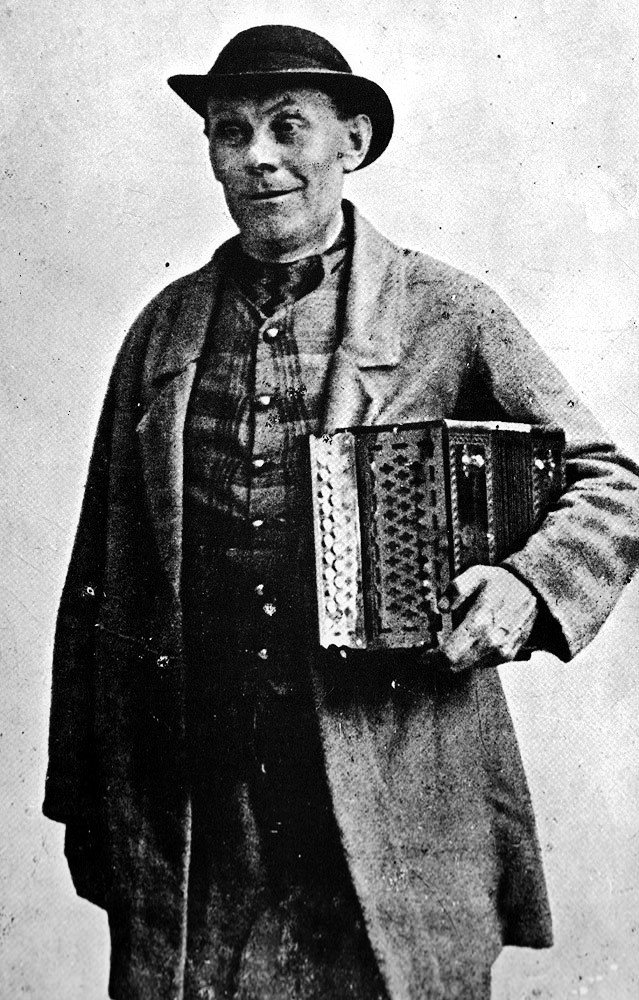
Thus sang Theodor Lorentz Larsson, aka ham comedian Lasse from Skåne, in the twenties and there is certainly something strange about electricity. I don't get any wiser no matter how much I read about it. All living organisms are constantly taking in and releasing energy and electricity manifests itself in a variety of forms; such as lightning, static electricity, electromagnetic fields and electromagnetic induction. Our thinking – our brain – is mostly powered by electricity.

A couple of my friends have recently suffered from various, rather dramatic changes in their brains and I have increasingly come to think about electricity, personality ,the soul and consciousness. It's probably my own age that's haunting me - the older I get, signs of aging will appear and steadily become worse.
It is only in recent years that I have come to think about body and health. I could previously identify myself with the chain-smoking, hypochondriac Zeno Cosini’s description of his father in Italo Svevo’s novel Confessions of Zeno:
My pursuit of health had lead me to study the human body. He, on the other hand, had succeeded in banishing from his memory all thought of this terrible machine. As far as he was concerned the heart did not beat, and he had no need to remind himself of valves and veins and metabolism to explain why he was alive. … For him the earth was motionless and solid, poised between its poles.
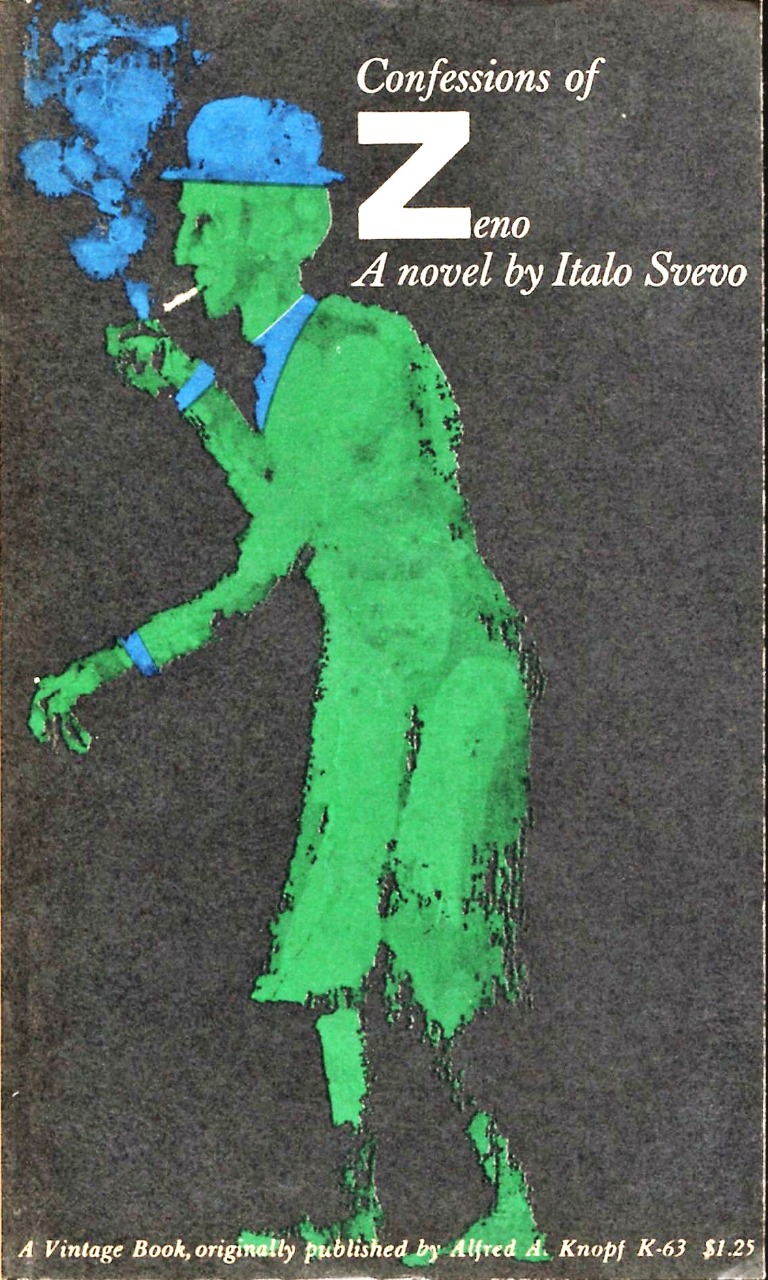
I have now been shoved into magneto encephalography (MEG) machines that measured and photographed my brain’s electrical currents, as well as I on a screen have watched my resilient heart beating, something it has done for almost seventy years – at least sixty beats a minute, night and day. Incomprehensible. What makes it go on like that? Where is the power behind all this? What is life? Is it all electricity based? The entire Universe?
 _
_
Everyday miracles, like the constant activity of the gelatinous, folded lump of fat and proteins that is hidden behind the shell of the skull. One and a half kilograms packed with 86 billion neurons, which through electrical impulses and chemical signals control and coordinate thoughts, feelings, behaviour, body movements and sensory impressions. From this organ emanate nerve fibres scattered throughout the body, from where they receive and transmit signals to the grey fat mass, which processes and interprets them, during wakefulness as well as sleep.

With new insight I read Walt Whitman's I Sing the Body Electric in his Leaves of Grass from 1855. In that long poem Whitman describes the human body as a miracle. How it gives each of us our distinctive character, while it at the same time connect us with other individuals, as well as the entire humanity, yes - with the Universe. To have a body means, according to Whitman, that you are an integral part of a beautiful, well-ordered, fantastic and joyful Cosmos.

Like several of Whitman's poems I Sing the Body Electric is partly a list, which powerfully, lyrically and enthusiastically presents a catalogue of human body activities; our thoughts and how they are connected to our bodies. Whitman describes a variety of external and internal body parts in a way that reminds me of James Weldon Johnson's gospel song Dem Bones:
Toe bone connected to the foot bone
Foot bone connected to the heel bone
Heel bone connected to the ankle bone
Ankle bone connected to the leg bone
Leg bone connected to the knee bone
Knee bone connected to the thigh bone
Thigh bone connected to the hip bone
Hip bone connected to the back bone
Back bone connected to the shoulder bone
Shoulder bone connected to the neck bone
Neck bone connected to the head bone
Hear the word of the Lord!
Dem bones, dem bones gonna walk around.
Dem bones, dem bones gonna walk around.
Dem bones, dem bones gonna walk around.

In Johnson’s song, it becomes clear that it is the power of God that gives life to our bodies. The poet and politician James Weldon Johnson wrote more than 200 songs for various Broadway musicals. For Dem Bones he found inspiration in a vision by Ezekiel:
The hand of the Lord was upon me, and carried me out in the spirit of the Lord, and set me down in the midst of the valley which was full of bones and caused me to pass by them round about: and, behold, there were very many in the open valley; and, lo, they were very dry. And he said unto me, Son of man, can these bones live? And I answered, O Lord God, thou knowest. Again he said unto me, Prophesy upon these bones, and say unto them, O ye dry bones, hear the word of the Lord. Thus saith the Lord God unto these bones; Behold, I will cause breath to enter into you, and ye shall live: And I will lay sinews upon you, and will bring up flesh upon you, and cover you with skin, and put breath in you, and ye shall live; and ye shall know that I am the Lord.

The Bible proclaims God’s Great Power, how it permeates the Universe in the form of The Holy Spirit. Several years ago I wrote about how peasants in the Dominican countryside worshiped a divine force which came forth in springs, caves, crops and not least in people. I called the book I wrote The Great Power of God in the San Juan Valley.

According to Christian doctrine, God’s Spirit is present in all true believers. It gives knowledge of God, unites His creation with Him. The Holy Spirit provides a foretaste of and a guarantee for the establishment of The Kingdom of God on earth. The Spirit is eternal, like God and Christ, it is omnipotent, omniscient and omnipresent. It creates and sustains the World, gives it life.
.jpg)
That a life-sustaining force pervades the entire Cosmos is far from being a notion unique to Christianity. Such a thought seems to exist within most religions. In 1917, the German historian of religions Rudolf Otto published his influential book The Idea of the Holy: An Inquiry into the Non-Rational in the Idea of the Divine and its Relation to the Rational, in which he argued that every human being deep within has a sense of the presence of a supernatural force, or “reality”. Otto described this presence as numinous, a word derived from the Latin Numen, a spirit, or force, the antique Romans assumed to be present in nature. A force that is “holy” in the sense of being separate/different and thus it is also a Mysterium tremendum, a grand and terrifying mystery, while at the same time it is a Mysterium fascinans, something that fascinates and attracts.
.jpg)

The British ethnologist Robert Ranulph Marett (1866-1943) gave the belief in an all-ruling power the Polynesian name mana, a term denoting a kind of spiritual energy that is not solely present in individuals. Entire peoples, governments, places, and even inanimate objects can possess mana. Mana generally protects what/whoever it encompasses, but it can also prove to be far too strong and thus harmful. According to Marett, the concept of power was the origin of all religion.
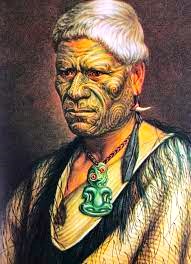
Notions of power is also present in science. The Three Laws of Thermodynamics indicate the presence of a force in the Universe:
• Energy is transported by heat and can neither be created nor destroyed.
• Disorder, entropy, constantly increases in the Universe and causes all natural processes to move in one direction
•Absolute Zero is the temperature at which the vibrations of atoms and molecules completely stop. However, the Uncertainty Principle of quantum mechanics forbids such a situation.
The Second Law implies that everything ages and dies. The Greek prefix en- means “within” and the word troproten “change”. The word entropy can thus correspond to “change within (a closed system)”. In science, entropy can be said to be a disorder which is created by the fact that energy/heat sources, such as the sun, are over time losing more heat than they regain. This appears to be the case throughout the Universe. Everything ages and dies, just like we and our brain cells. Nevertheless, doesn't the first law of thermodynamics state that energy can neither be created, nor destroyed, so how come that everything ages and dies?

The Uncertainty Principle means that a particle can actually function as a wave function and not only be a point-like object and therefore it cannot have both a well-defined position and a momentum. Do I understand that? Not at all. An acquaintance from my hometown, a former schoolmate who now is a mathematician and nuclear physicist, told me when I asked him to explain something about quantum physics: “I'm sorry, Jan, but if you’re bad at math can't it's almost impossible.” I have always been lousy when it comes to mathematics and it is a small consolation that the possibly the greatest nuclear physicist of them all, the Dane Niels Bohr (1885-1962) wrote:
Those who are not shocked when they first come across quantum theory cannot possibly have understood it [...] We must be clear that when it comes to atoms, language be used only as in poetry. The poet, too, is not nearly so concerned with describing facts as with creating images and establishing mental connections.
But that is actually not at all a consolation. Bohr was a master mathematician and his mind was unfortunately considerably greater than mine.

When I in the following speculate about life, energy and the brain, I do so well aware of my own ineptitude and it comes to mind how in 1996 the physics professor Alan Sokal in a scientific magazine published an article he called Transgressing the Boundaries: Towards a Transformative Hermaneutics of Quantum Gravity. The article applied an extreme relativism, but was in fact pure rubbish, a crazy concoction of postmodern platitudes. Despite this, Sokal’s essay was perceived as a serious account of the connection between physics and philosophy. Shortly afterwards, Sokal revealed that it had all been a “joke” aimed at “the pretentious and amateurish abuse of recent physics by leading French theorists, such as Derrida, Lyotard, Baudrillard and Kristeva.” Some of these French philosophers actually fascinate me, especially Derrida and Baudrillard. I am thus convinced that if Sokal had, which is highly unlikely, seen what I am writing, he would certainly have perceived me as yet another postmodern dilettante, more confused than the French professors he enumerated.


Back to poetry. Whitman’s I Sing the Body Electric is much more than an enumeration of body parts, activities, opinions, memories, and poignant images. According to him, everything he mentions constitute the basic material for dreams and poetry. The poem deals not only with the body, it concerns a symbiosis between body and soul how they together receive the all-encompassing power of the Universe. For Whitman, the body is sacred, it is not only a companion and servant of the soul, but also its accomplice. Accordingly, our body is united with the Universe, an abode of the all-encompassing soul, enabling not only human spirituality, but also a sense of belonging and poetry. Body and soul are sacred.
I sing the body electric, .
The armies of those I love engirth me and I engirth them, .
They will not let me off till I go with them, respond to them, .
And discorrupt them, and charge them full with the charge of the soul. .
[…].
and if the body were not soul, what is the soul?

The Whitman admirer Allen Ginsberg reflects in his Footnote to Howl along similar lines of thought:
Holy! Holy! Holy! Holy! Holy! Holy! Holy! Holy! Holy! Holy! Holy! Holy! Holy! Holy! Holy!
The world is holy! The soul is holy! The skin is holy! The nose is holy! The tongue and cock and hand and asshole holy!
Everything is holy! everybody's holy! everywhere is holy! everyday is in eternity! Everyman's an angel!
The bum's as holy as the seraphim! the madman is holy as you my soul is holy!
The typewriter is holy the poem is holy the voice is holy the listeners are holy the ecstasy is holy.


A distinctive feature of Whitman’s poetry is his association of it with a democratic feeling, as well an often almost tangible expression of power and change, linked together within a pantheistic universality. Everything is animated. Rarely has Whitman’s enthusiastic pantheism been reflected as beautiful as in the poetry of Finland-Swedish Edith Södergran (1892-1923):
What do I fear? I am a part of infinity.
I am a part of the great power of the universe,
a single world within a million of worlds,
a star of the first magnitude which is extinguished at last.
A triumph to live, a triumph to breathe, a triumph to exist!
A triumph to feel time run icy cold through your veins
and hear the silent river of night
and stand on the mountains under the sun.
I walk on sunshine, I stand on sunshine,
I know of nothing but sunshine.

It was only by the end of the 19th century that electricity was transformed from being a scientific curiosity, or mystical godly force, to become one a prerequisite for our modern existence. When Whitman paid homage to the “electrified body” advanced electrical technology was still in its infancy and it was only later that “electrical” geniuses like Bell, Bláthy, Edison, Kelvin, Siemens, Tesla, and several others like them appeared on the scene.

What Whitman got right was the connection between body, thoughts and electricity. He found himself in the midst of the age of galvanism, i.e. electric current produced by chemical processes, not the least within the human body.
During the 17th century, some philosophers had begun to consider the body as nothing more than matter subjected to mechanical rules. The concept of soul became the same as the human mind/consciousness/reason. The brain became the seat of the soul and the nerves mediators between soul and body.
It was only a few philosophers/natural scientists who assumed that soul and body could in fact be one and the same, i.e. constitute parts of a single common substance. Pre-Christian Greeks imagined such a substance as an extremely subtle and refined fluid – pneuma. In principle, both soul and matter were thereby tangible. A school of thought that was pushed to its limits by the French physician Julian Offray de La Mettrie (1709-1751) who, in his L'Homme Machine, argued that moral judgment, free will, yes – any thought and thus also what the Christians calls “soul” were nothing but bodily functions based on how a human body is composed. La Mettrie denied any divine presence in human existence. However, a crucial question remained – What kind of force could sustain and gave life and movement to the entire Universe?


According to La Mettrie, bodily functions were activated by what the philosopher and mathematician Gottfried Wilhelm von Leibnitz (1646-1716) had called Vis viva, Living force. A concept based on what in physics cam to be called the Energy Principle, i.e. that energy can neither be created nor destroyed, only transformed. This is how, for example, potential energy is transformed into kinetic energy (from the Greek word for movement and work). Potential energy rests in a bow. When the bowstring is released, i.e. set in motion/work, energy is transformed from being dormant (potential) energy into motion/kinetic energy. It is such interactions between rest and movement, cause and effect, which according to La Mettrie and Leibnitz keep the body going.
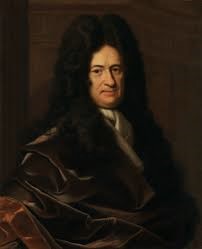

In 1752, Benjamin Franklin had during a thunderstorm brought his finger close to a key connected to a kite by means of a metal line. He saw and felt a spark and thereby understood that the “positive” tension of the key had been activated by the “negative” tension in his hand, thus Franklin was able to introduce into science the concepts of positive and negative charge.

Luigi Alosio Galvani (1737-1798) was from 1776 professor at the University of Bologna, where he taught anatomy, which made him well acquainted with autopsies, a specialty for which the Universities of Bologna and Padua were famous. In 1780, Galvani, apparently inspired by Franklin, attached by means of hooks several frog legs to a metal rod, which was connected to a lightning rod. Galvani then discovered what he called animal electricity. When a flash of lightning struck, the frogs’ legs twitched in spasmodic movements. Galvani soon found that the phenomenon could be repeated even when he pressed his fingers on the brass hooks he had attached to the spinal cords of dead frogs. Apparently, the human body also harboured electrical voltages.

Galvani's contemporary Alessandro Volta (1745-1827) was professor of “experimental physics” at the University of Padua. When he checked Galvani's experiments, he found that the twitches in the frog legs were not produced solely by lightning strikes, or Galvani touching the hooks. In fact, the phenomenon arose through the metal cables that Galvani had used to connect nerves and muscles. Volta therefore hypothesized that electricity was propagated through the dead frog’s body via electrochemical cells and that such energy generation could also take place outside of an animal body.

Volta constructed what came to be known as a Voltaic Pile, the first electrochemical battery. Alternately, he stacked copper and zinc sheets on top of each other, separated by pieces of cloth soaked in brine. When the upper and lower metal layers were joined by means of a metal wire, electric current flowed through wire and Voltaic Pile.

It was not only Galvani's discoveries that inspired Volta, but also the inventions of the Swedish physicist Johan Carl Wilcke (1732-1796). Wilcke was born in Wismar, a town that at the time was part of the Swedish empire. At the age of five, he had followed his father to Stockholm, when he became a pastor at the German Church. Wilcke later became a doctor after presenting his thesis De electricitatibus contrariis, The Opposites of Electricity, at the University of Rostock. In Sweden, Wilcke received a professorship at the University of Uppsala and was elected to the Royal Swedish Academy of Sciences, after submitting two theses - Findings Concerning the Production of Electric Charge with Other Objects than Glass and Porcelain and History of Naturalists’ Opinions Related to the Causes of Thunder. In 1762, Wilcke invented a friction machine which he called electrofor.

The electrofor consisted of a “dielectric” plate made of pitch or wax and a metal plate with an insulating handle. By being rubbed against fur the dielectric plate became statically charged. Note the dead cat in the picture. A metal plate was then placed on the dielectric plate, thereby it became grounded with a positive charge. The positively charged metal plate was then removed from the dielectric plate. The positive charge of the metal plate remained and could be used for various electrical experiments. The voltage in the metal plate could become quite high.

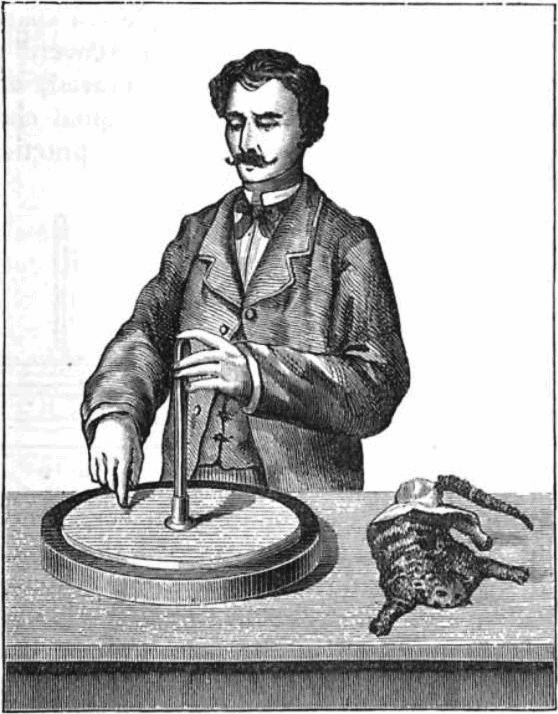
An Italian fresco depicts Volta demonstrating his Voltaic Pile to Napoleon, it also depicts him using an electrofor.

Eight years after Wilcke, Emanuel Swedenborg (1688-1772), on the famous botanist Carl Linnaeus’ recommendation, elected to the Royal Academy of Sciences. Swedenborg was then an internationally recognized author, natural philosopher, mining engineer, inventor and scientist. Four years later, in 1744, a spiritual phase began in Swedenborg’s life when, through dreams and visions of a spiritual world, he was enabled to speak with angels, spirits and the deceased. Swedenborg considered himself appointed by God to spread a heavenly doctrine. He claimed that God had opened his eyes and mind so he could visit Heaven and Hell. During the next 28 years of his life, Swedenborg wrote in Latin and published eighteen unusually extensive theological works.

The main reason for Swedenborg being elected to the Academy and appreciated by esteemed scientists like Linnaeus and Wilcke was his treatise Oeconomica regni animalis in which he described and analysed the structural and functional organization of the cerebral cortex, the structure of the nervous system and cerebrospinal flow and secretions emanating from the pituitary gland .

Upon entering the Royal Academy of Sciences, Swedenborg presented his work De cerebri motu et cortice et de animo humano: anatomice, physice et philosphice perlustrata which he in 1740 had published in Amsterdam. In this book The Brain and the Movements of the Cerebral Cortex and the Human Mind: Anatomically, Physically and Philosophically Examined, Swedenborg described how various processes of the brain were caused by breathing.
Swedenborg had spent 18 months in Paris and there become acquainted with the world-famous French scientist and anatomist Jaques-Bénigne Winslow (1669-1760), who performed public dissections in his Amphithéâtre Winslow. A pompous anatomy hall which still can be visited by the Rue de la Bûcherie.

The original name of famous anatomist was actually Jacob Benignus Winsløw. The strange surname came from the fact that he was Danish and that his father had been born in the Scanian village of Vinslöv, not far from my place of birth, Hässleholm. Swedenborg owned Winslow's extensive Exposition anatomique de la structure du corps humain and it was primarily through such anatomical writings that Swedenborg based his insightful observations and speculations. He was early on aware of the fact that brain activity was dependent on chemical processes and something that could be compared to electrical impulses.


After his time in Paris, Swedenborg spent more than a year in Venice and it was probably there that he became familiar with the theories of Marcello Malpighi. It was the microscope that had opened up a new world for Malpighi (1628-1694). Like so many before him, he had searched for an explanation to the enigma of life. What makes us live? Among other things, it must be the lungs that keep us alive. It's not just humans who breathe, animals do it as well. Insects also need to breathe, but do they have lungs? Malpighi used the microscope to find out. He found that insects do not use lungs as their respiratory organs but small holes in their skin which he named tracheae.


From insects, Malpighi moved higher up on the evolutionary ladder and microscopically examined the airways of dissected human lungs. He found how the airways branched out in the form of thin membranous and spherical cavities that he likened to the bees’ wax cakes. He gave them the name alveole, small cavities. Continuous inhalation and exhalation fills and empties the alveoli with air. Malphigi wrote in his De pulmonibus observationes anatomicae that the alveoli functioned as “imperfect sponges” and brought air into the blood, which then distributed the “Spirit’s” life-giving power throughout the entire body. Like several other anatomists, Malphigi was a skilled draughtsman who carefully copied what he had seen under his microscope.


In search of other microscopic structures that could explain the secrets of life and the passage of air through the body, Malpighi continued his search in other body parts of the body, not least the brain. In 1665 he published three works in which he described his findings - De Lingua, dealing with the tongue and the origin of taste, De Externus Tactus about the sensory sensations produced by touch, something that finally led him into the brain and nervous system, which he described in De Cerebro, About the Brain. Especially the latter work was devoured by Swedenborg, who just like Malpighi was searching for the seat of the soul in the body.
Swedenborg sensed that the personal, spiritual life was dependent on the brain. Consistent with his mechanical mind-set, he believed that the soul works in harmony with the space that surrounds us and that life is brought about by a perpetual movement of extremely fine particles in the surrounding air. Influenced by Leibnitz, he introduced the possibility that through careful study, a collection of all the observations he and other researchers had made, he would finally find the seat of the soul inside the human body. A rigorously applied experimental science and mathematical probabilities would determine the exact position of the soul, its importance for maintenance of life, and the contact it has with a cosmic creator god.

When he microscopically examined tongue tissue, Malpighi had found small “taste buds”, which he called papillae. He discovered that they were connected to nerves leading into the brain. Malpighi had previously found that the body’s nerves were connected to various secretion-producing glands. While studying the brain, he mapped its grey and white tissues and concluded that the brain was also a secretion-producing gland that by means of nerve fibres through the spinal cord spread its signal fluids and thus gave and received information from all parts of the body.
Swedenborg was inspired by Malpighi's opinion that the small oval bodies he had found, surrounded by capillaries, were a kind of glandular structures with the task of separating and mixing different chemical, signal fluids. Swedenborg called them spherulae or cerebellula. He believed that all the nerve fibres of the brain were connected to different cerebellula, which were mainly concentrated in the pituitary gland and the grey cerebral cortex. According to him, impulses between organs and muscles were conveyed by tremulations, vibrations in the body fluids, a life-providing spiritus animalis, which was constantly pumped through the body. It was the myriads of cerebellum of the cerebral cortex that coordinated and linked all these tremulations into attention, memory, thinking and language, while the pituitary gland sent out and received information carrying nerve fluids.
_
According to Swedenborg, every form of life was linked to constantly vibrating tremulations that filled the entire Universe. The inner impulses/movements of brain and body were triggered by the breathing, which kept the entire Cosmos alive. When a person died, tremulations were still in nerve fibres and cerebellula. Angels compressed and collected all this stored life energy and brought it to another, spiritual existence.
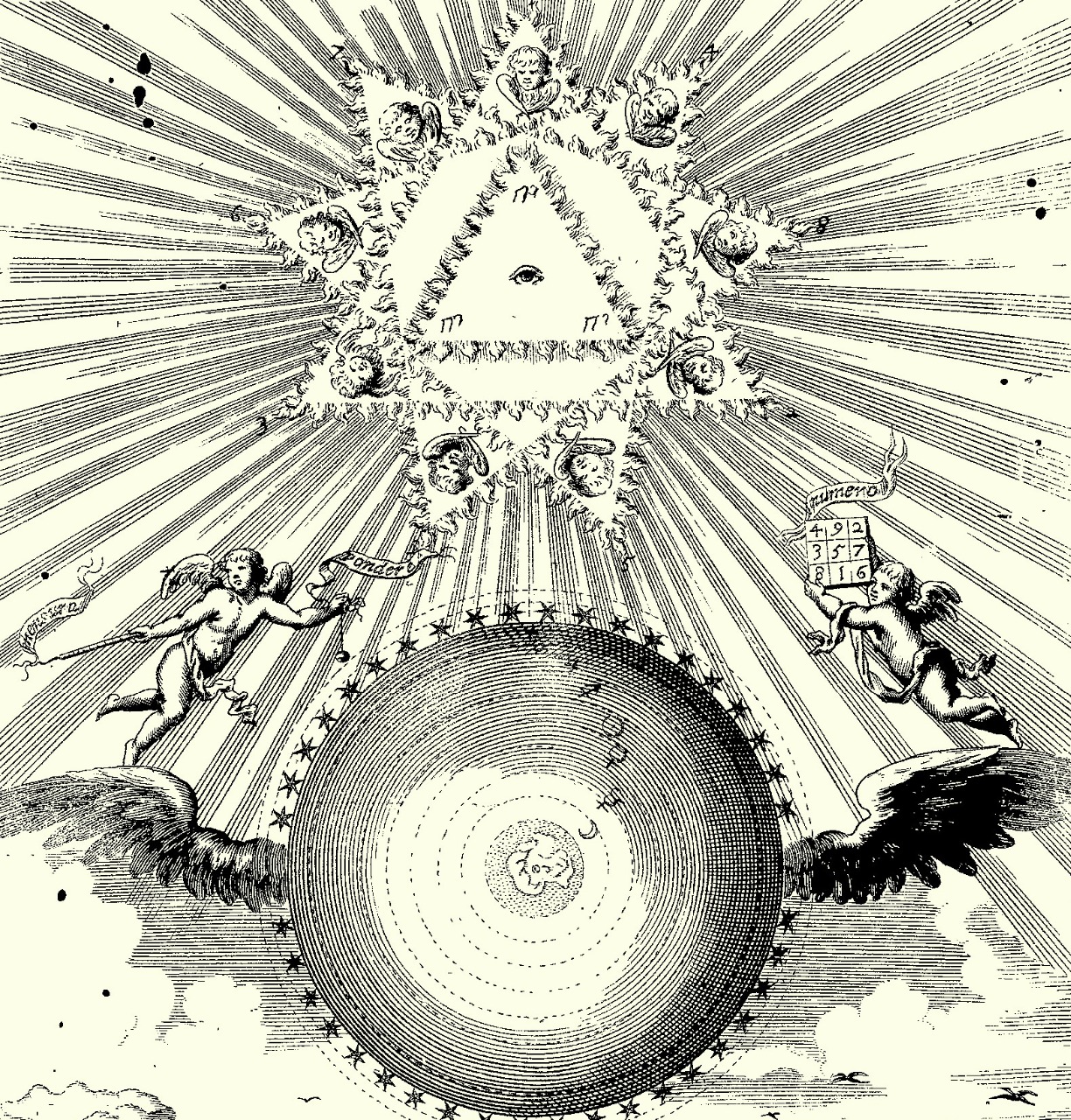
Swedenborg's cosmological perspective was all-encompassing. According to him, the Universe originated from various centres, or points of energy, from which suns and planets arose. Different spheres of animal, plant and mineral originated from similar elemental energy particles. Everything in the material world had its counterpart in a spiritual realm, everything served a purpose and followed certain cosmic rules. Contacts between spiritual and bodily realms occurred within the cerebral cortex. The lungs drew the spirit pulse of the Universe into blood vessels, which, in conjunction with the cerebellula, carried it to the cerebral cortex and pituitary gland, which converted this spiritual influx into body fluids, activated through the tremulations . This spiritual influx from a divine sphere enabled an individual to live and follow God's commandments. The human soul, which is the main component of the body, was actually made of the same substance as the cosmic life force.
When he in 1743 travelled to Holland and England to gather additional material for his attempt to explain the soul from an anatomical point of view, Swedenborg was already on the verge of leaving the scientific path. During a transitional phase he experienced sharp and vivid dreams, some with a strong erotic undertone. Dreams that he wrote down in Swedish in a private diary. In Amsterdam, he had a revelation of inner light: “My head was cleaned and cleared of what was supposed to obstruct its thoughts.” He felt “how my desire for women abruptly came to an end. It has always been my main passion.”

In April 1745, Swedenborg sat alone in a secluded room at an inn in London. His vision darkened while the room changed character. A man sitting in a corner said to him: “Don't eat too much”. Shaken, Swedenborg hurried home to his lodgings, During the night the same person appeared in his dreams. The man revealed to him that he was God himself and that he now appointed Swedenborg to reveal the true meaning of the Bible. Swedenborg’s entire being became subjected to a thorough change. He noticed how all his previous enthusiasm for scientific endeavours vanished and from then on he sometimes stayed in the Spirit World, sometimes here on earth.
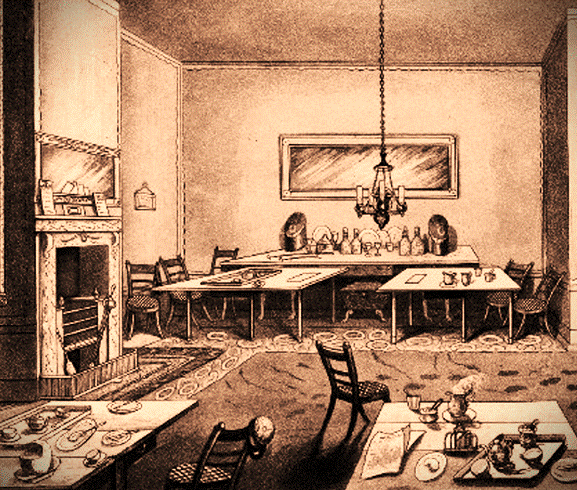

Swedenborg’s brain research had no major impact on contemporary scientists, who soon became excited by Galvani’s and Volta’s discoveries. However, a motley crew of conjurers, alchemists and spiritualists, however, adopted Swedenborg's theories, in particular his spiritual teachings about the correspondences between all living things and a spiritual realm.
The Swedish poet Johan Henrik Kjellgren was nineteen when Swedenborg died and it is doubtful whether he read any of his writings, but Kjellgren resented all those “dimwits” who took Swedenborg’s teachings seriously. According to Kjellgren, Swedenborg had once been a wise and completely sane person, but he had gone nuts and it was not possible to take his former genius as a pretext for Swedenborg's later eccentricities. In his poem Man does not possess genius just because he’s mad, Kjellgren lumps Swedenborg together with all kinds of charlatans.
Even if Newton one day was beaten down by spiritual fever,
Swedenborg is plain and simple — a douchbag.
Alas, you Swedenborgians! Alas, Rosencreutzians!
Alas, you dream interpreters! You treasure hunters!
Number Punctuators, Magnetizers,
Physionomists, Alchemists, Cabalists and Harmonists!
Your conclusion is twisted — a wise man can become mad;
A genius in one field, can be lost in another.

It was a time that by the Finland-Swedish author Zachris Topelius (1818-1898) was described as:
Just as the new light broke in, darkness appeared for another moment, more sinister than ever. It was a time when people bowed to Cagliostro more than to God. Never has alchemy had more ardent followers as when its better daughter Chemistry was carried to her baptism by Scheele and Bergman; and never had so many been chasing after an elixir of life than when Voltaire and Holbach taught that the soul is nothing else but matter, doomed to perish with the body.

A time that Ingmar Bergman depicted in his film The Face and Per Olov Enquist in his novel The Magnetist’s Fifth Winter. The latter spins a story around a certain Friedrich Meisner, a charlatan just like Albert Emanuel Vogler in Bergman's film. One cannot avoid connecting Enquist’s Dr. Meisner with Franz Anton Mesmer (1734-1815), who despite his obvious quackery, cannot be denied a prominent place in the history of medicine and psychology.

.jpg)
Mesmer, was a German physician who assumed that there was a natural energy transferable between all forms of living things, something he called Magnetisme animal. An energy which, according to Mesmer, could become a cure for a variety of disease-like conditions. The treatment consisted of Mesmer sitting in front of a patient while touching his/her knees with his legs, pressing the patient's thumbs and staring into his client’s eyes. He then moved his hands to the patient's shoulders and with utmost ease and care moved his hands all over the body, until his fingers reached a place just below the perineum. He was then kept his hands there for more than an hour. Like Swedenborg, Mesmer assumed that there was a life force hidden in humans and animals and that through his method he would be able to bring this force’s beneficent abilities to life. Mesmer was well paid for his activities and invented several alternative methods of “power transfer”.

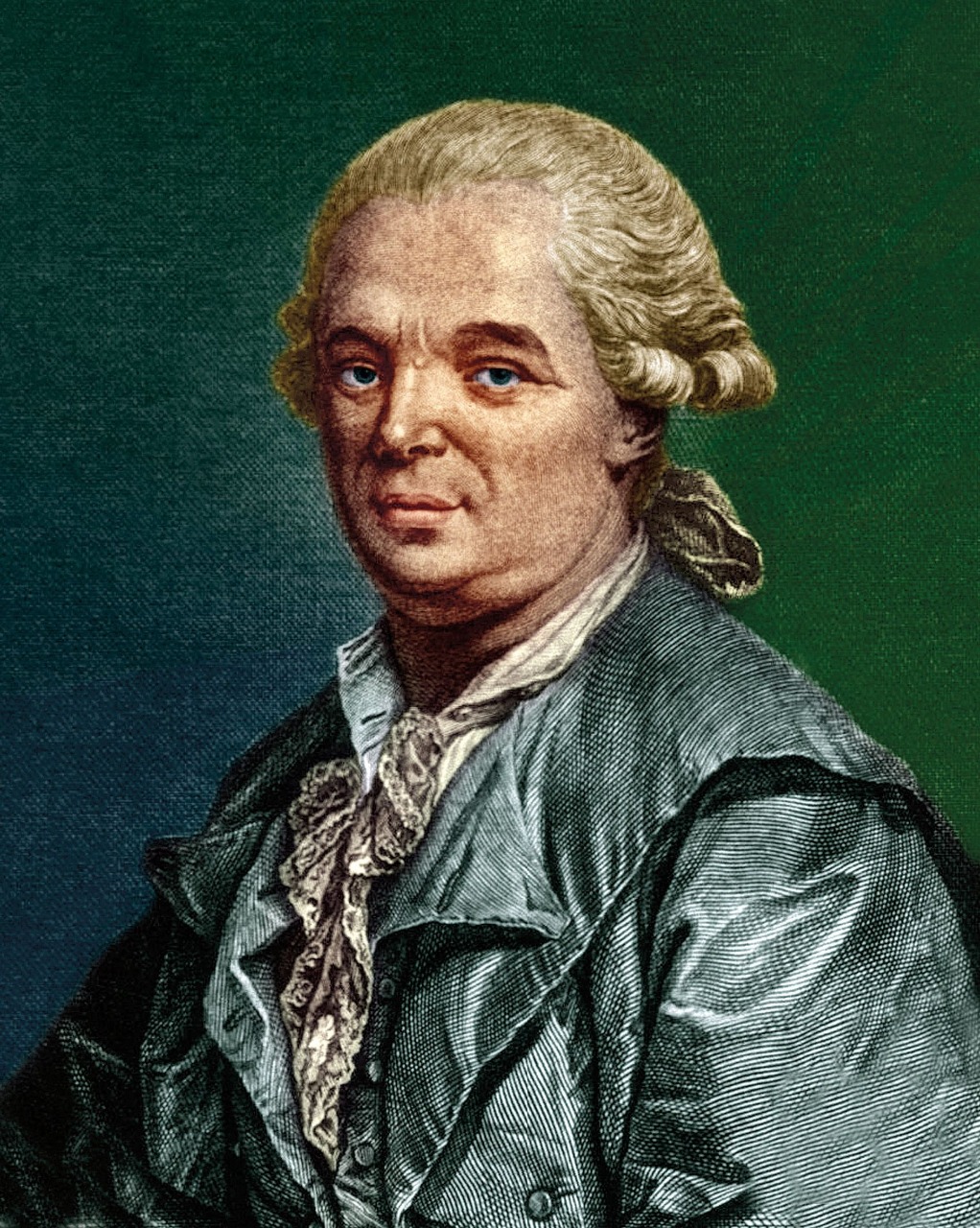
To investigate Mesmer’s claims and practices, Louis XIV appointed in 1784 a scientific commission. It included such scientific greats as the chemist Lavoisier, the astronomer Bailly, the botanist de Jussieau, the physician Guillotin and Benjamin Franklin. The Commission's conclusion was that participants’ expectations and imagination, combined with the ambience produced feelings of being “cured” and/or enlivened:
having demonstrated by decisive experiments, that the imagination without the magnetism produces convulsions, and that the magnetism, without the imagination produces nothing; [the Commissioners] concluded with an unanimous voice respecting the existence and the utility of the magnetism, that the existence of the fluid is absolutely destitute of proof, that the fluid having no existence can consequently have no use, that the violent symptoms observed in the public process are to be ascribed to the compression, to the imagination called into action, and to that propensity to mechanical imitation, which leads us in spite of ourselves to the repetition of what strikes our senses.

Mesmer's credibility suffered a major blow, but he was nevertheless able to continue his activities until his death.

The connection between electricity, spiritual life, faith and science did not cease to fascinate a large part of Europe's intelligentsia. When the precocious Percy Bysshe Shelley (1792-1822) published his poem Queen Mab in 1813 it was printed in 250 copies, of which Shelley personally distributed 70 copies to close friends and like-minded acquaintances, the rest were stored at a bookseller. The long poem is characterized by scientific language and theorizing within a fairy tale frame in which the fairy queen Mab descends in a dream to the sleeping Ianthe and takes her soul to her enchanted palace by the outermost limit of the Universe.

Mab interprets, analyses and explains Ianthe's dreams, as she transforms several of them into visions of the past, present and future. The present is characterized by oppression, injustice and misery caused by religion, commerce and monarchies.
All seems unlink'd contingency and chance,
No atom of this turbulence fulfils
A vague and unnecessitated task,
Or acts but as it must and ought to act.
Even the minutest molecule of light,
That in an April sunbeam's fleeting glow
Fulfils its destin'd, though invisible work,
The universal Spirit guides.

Shelley believed that the soul was not at all an individual entity, a free-acting will, but a universal, all-embracing force, a constant movement constituted by a vast, unbroken chain of cause and effect. To that extent, he makes me think of Buddhism’s anattā, the doctrine of the non-self/soul.
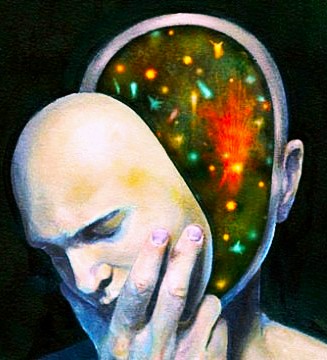
Buddhist philosophy declares that there is no unchanging, permanent “I”. We are all nothing but a shifting composition of sense impressions and emotions. That which generally is called soul –Ātman is an reality the ultimate, indescribable force that permeates and includes the entire Universe. Ātman operates in the Universe through movement — karma, a Sanskrit term meaning “action” or “doing”. In Buddhist scriptural tradition, karma refers to actions driven by intention, cetanā, and will inevitably have future consequences.

Because the anattā doctrine denies the existence of an I, i.e. a personal soul, Ātman thus becomes the driving force of the entire Cosmos. The word ātma finds its origin in the Indo-European *ēt-men, breath. Thus, according to Buddhist philosophy, all life is produced by atman, which manifests itself through movement caused by karma. Within modern Buddhism, it is therefore not uncommon for karma to be compared with Newton's three laws of motion:
• A body will either stay in its original, or when it moves maintain a constant speed – if no external force affects it.
• Acceleration is needed to make a body move. It is as large in size and direction as the force it is made of and it is calculated as speed per unit of time.
• If a body A exerts force on a body B, then B exerts an equal but opposite force on A. This third law is often called the law of action and reaction.
Leonardo da Vinci was an ever-curious, searching universal genius who saw movement everywhere. Like Buddhists he proclaimed that “movement is the cause of all life.” His fascination with movement is clearly demonstrated in his many descriptive studies of movement in nature: water, birds, canon ball tracks, people, etc.



In his Last Supper, Leonardo presents a great variety of human emotions, where each character reflects emotions through bodily expressions. He wrote:
A skilled artist must be able to paint two things: people and people's thoughts.
Leonardo assumed that emotions and natural forces are governed by similar laws to those that govern psychological and physical movements and thus, unlike most contemporary thinkers, he did not draw a sharp dividing line between the material and the spiritual.


Shelley devoured a wealth of writings on the origin and maintenance of life. In his poetry, as in Queen Mab, he tried to reflect his thoughts, well aware that they could give him a lot of trouble. The bookseller to whom Shelley entrusted his undistributed copies of Queen Mab began, without Shelley's knowledge and consent, to sell them a year before the poet in 1822 drowned in the Italian Gulf of La Spezia. When another edition was printed, the disaster became a fact. The Society for the Suppression of Vice pounced on Queen Mab, condemning it in harsh terms. This association which, with royal consent, promoted “public moral" and thereby censored obscene and heretical writings, as well as it occasionally brought their authors to justice. The moral Society saw to it that the bookseller was sentenced to four months’ imprisonment. Shelley had left England four years before the incident, to escape from its “civil and religious oppression”, but also due to his tangled private affairs, both financial and amorous. His wife Harriet had killed herself while he was living openly with his mistress Mary, whose sister Fanny at the same time also committed suicide.

Because he had attacked the Church and denied the existence of a personal, omnipresent deity, Shelley was accused of subversive atheism. He believed that science had proven that there is no God who created man in his own image. Instead he divulged his belief in an impersonal cosmic energy that governs and pervades everything. An insight he based on his studies of, among other things, galvanism, which at the time had become fashionable throughout Europe. Galvani was searching for the strange and apparently universal energies which, according to him, constituted the Soul of the universe. During the 1780s, Galvani had with an assistant crisscrossed the European continent, demonstrating how electric shocks made carcasses of various domestic animals to twitch and move, just as if they were alive. Phenomena that Galvani even demonstrated by connecting the corpses of executed murderers to electricity-generating devices and acids.

A combination of mysticism with physics made many believe that galvanic electricity proved the presence of God’s Holy Spirit within His creation. An Italian physicist, Giovanni Aldini (1762-1834), followed in the footsteps of his uncle Luigi Galvani. He seemed to be intent on reviving dead people by means of electricity. For such a purpose he used Volta’s electricity piles. Aldini performed his experiments on bodies of executed criminals. One problem, however, was that in Italy, Germany and France, people sentenced to death were generally beheaded. Aldini wanted access to fresh, completely intact corpses and accordingly he travelled to England, where criminals were hanged.

The Newgate Calender, which with a “moralizing intention” reported on heinous crimes and spectacular executions, did in 1803 describe how shortly after the execution of George Foster (accused of drowning his wife and one of his daughters) Aldini performed a public experiment on the body. Aldini connected two metal rods to a large voltaic pile containing 100 zinc and 100 copper discs. When he touched the cadaver’s mouth and one ear with metal rods attached to the battery, the jaws of the deceased criminal began to tremble, adjacent muscles became terribly contorted, and one eye opened. In the subsequent part of the process the corpse's right hand was raised and clenched, while legs and thighs were set in motion. By moving one of the rods to the corpse’s rectum, the movements were accentuated to such an extent that the corpse appeared to be reanimated and the deceased man seemed to breathe again.
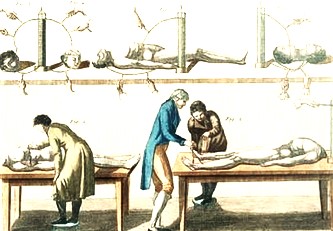
The Newgate Calender’s account is reminds of Mary Shelley's description of how Frankenstein gave life to his monster:
It was on a dreary night of November that I beheld the accomplishment of my toils. With an anxiety that almost amounted to agony, I collected the instruments of life around me, that I might infuse a spark of being into the lifeless thing that lay at my feet. It was already one in the morning; the rain pattered dismally against the panes, and my candle was nearly burnt out, when, by the glimmer of the half-extinguished light, I saw the dull yellow eye of the creature open; it breathed hard, and a convulsive motion agitated its limbs.

The similarities are by all accounts no coincidence. Mary's husband certainly harboured a kind of idealism based on electrochemistry. During his time at Eton College, Shelley came under the influence of the paternal freethinker Dr. James Lind, who early on had noticed the outspoken, very intelligent, but sadly bullied and original Percy Bysshe Shelley, who in his despair occasionally was seized with violent rage and thus came to be known as Mad Shelley.
Dr. Lind assumed that galvanic/animal magnetism/electricity proved that all the forces/energies of nature were united in a “cosmic soul”. Dr. Lind was well acquainted with the theories and activities of Galvani and Aldini. Shelley attended and became fascinated by Dr. Lind's experiments with “animal magnetism”, how he by using various power sources made dead frogs jump, or the muscles of various reptiles contract and move in an almost uncanny way. Dr. Lind, who was an enthusiastic Freemason, encouraged Shelley's occult interests and inspired by his mentor Shelley interweaved of bold metaphysical speculations with new scientific findings and subversive political views.

Shelley developed his radical way of thinking in a direction he perceived as “poetry of life”, which according to him meant that thought, language and imagination developed through interaction with the combined forces of nature and man, expressed through social relations based on free love, compassion and power. By “power” Shelley meant a dominant force based on social, intellectual and scientific freedom. According to him, scientists were more or less unconsciously searching for the answer to one single question – How can intellect and civilization be reconciled with pleasure and amusement? Is it possible for us humans, without a belief in an inhibiting God, to indulge ourselves in the limitless freedom of life? Unite with the Great Power of Universe? Thoughts similar to the cosmic expansion/joy that later found its expression in Edith Södergran’s Triumph to Exist.
In 1820, Shelley published his reading drama Prometheus Unbound. It was not written for the stage, but to stimulate the reader's imagination. His aim was for the drama to interact with the reader's own imagination. Shelley’s role models were Satan in Milton’s (1608 -1674) Paradise Lost and Prometheus in Aeschylus’ (525-456 BC) trilogy Prometheia.

By Milton, Satan, like Prometheus, fights against God’s Creation, i.e. the entire Universe. However, Satan loses his heroic aspect through his insane vengefulness against an all-powerful and punishing God. Satan ends up as an enemy of all mankind, which was created in the image of God. Satan and Prometheus share a hate for all-powerful gods, who rely on terror and censorship to maintain their dominion over us all.
In Shelley’s Prometheus Unbound, Jupiter represents the unyielding Fate, a force opposed to individual free will, which the revolutionary Prometheus, who does everything to support human independence from a tyrannical God. Shelley's Prometheus urges us humans to nurture compassion with all living creatures. His Prometheus shapes himself into an image of highest perfection, a moral and intellectual giant. Driven by pure and honest purposes, he tries, with the help of science and love, to lead humanity towards a future Utopia, based on just laws promoting free will, while prohibiting all harmful egoism. Thoughts Shelley exchanged and shared with his similarly liberated, young wife.


Mary Shelley was born in London in 1797 and was then named Mary Wollstonecraft Godwin. She was the first child of the political philosopher, writer and journalist William Godwin and the second child of the feminist philosopher Mary Wollstonecraft. The mother died ten days after Mary's birth. Godwin was left alone with the responsibility of raising Mary and her older half-sister Fanny. Mary loved her father, but hated the woman he married four years after his first wife’s demise.
Mary and Percy Shelley, who was a good friend of her father, fell in love and met secretly by Mary Wollstonecraft’s grave. Mary was seventeen and the already notorious Percy twenty-two. In April 1814, the couple travelled secretly to France, Germany and Switzerland. They took Mary's stepsister Claire with them, but Percy’s pregnant wife was left alone in England. There was for the time being peace in Europe, while an imprisoned Napoleon sat on Elba and brooded on revenge and another war. The runaways’ money soon ran out and after six months the pregnant Mary and an impoverished Percy were forced to return to England. There, Mary's father and Percy’s relatives did not want to hear from them.

During her stay abroad, eighteen-year-old Mary had begun to write a novel that over time would turn into a strange and very persistent legend. At a very young age, Mary had already experienced great and subversive love, motherhood, death and misery, all combined with a rebellious young woman’s feelings of alienation and bewilderment. Through all this, she managed to create her multi-layered novel about Dr. Frankenstein’s nameless monster.
Mary and Percy had for a time lived with the self-proclaimed demonic Lord George Gordon Byron, lover of Mary’s sister Claire. Even before their departure, or rather flight, from England, Shelley had suffered from strange delusions. Shelley was a great admirer of Byron's poetry and had sent him Queen Mab and several other of his poems. Byron, who lived in Villa Diodati by the shores of Lake Geneva, had become impressed and enthusiastically welcomed the young couple. They were evening after evening, night after night, engaged in discussions about literature, science and “various philosophical doctrines”.

One night, while Byron was reciting his and Coleridge’s poems, Shelley suffered a severe panic attack with terrifying hallucinations. The previous night, Mary had had a nightmare that became the seed for her novel about the mad scientist Dr. Frankenstein. Throughout the summer the weather had been cold and rainy. On the night when Mary suffered from her terrible nightmare and Shelley wandered around their room, they had earlier together with Byron and his friend and doctor, John William Polidori, been sitting together in front of a fireplace, while reading aloud from a German anthology of horror stories. That same night, Polidori had been inspired to write a draft of what would become a novel about the first vampire of the modern genre - Lord Ruthven, a demonic aristocrat who lays waste to all and everything around himself.

When they well after midnight returned to their nearby villa, Shelley was agitated and Mary had difficulties in falling asleep. Between sleep and wakefulness she was seized by such a dizzying and detailed experience that she did not know whether it was a dream or a hallucination:
I saw the hideous phantasm of a man stretched out, and then, on the working of some powerful engine, show signs of life, and stir with an uneasy, half vital motion. Frightful must it be; for supremely frightful would be the effect of any human endeavour to mock the stupendous mechanism of the Creator of the world.
The dream exposed Mary’s feelings of loss, guilt, and the consequences of defying God, something her husband, with her consent had done through thought, speech, and action. There was also the loss of her mother, the complicated relationship with the father, the loss of her first child and worries about the child she carried in her womb. Later, Mary described her Swiss summer as the time when she “first stepped out of my childhood” and in the depths of her soul she felt alienated from the world around her. During their nocturnal discussions, Lord Byron and Shelley had frightened her by their lofty and almost fanatically romantic ideas. Mary wondered if such fanaticism, in conjunction with an increasingly advanced science and abused power, might not pose a threat to all human existence.

In Mary Shelley's novel Frankenstein, or the modern Promethues, we find reflections of her husband’s perceptions and wild speculations. Like Victor Frankenstein, Percy Shelley harboured an overriding desire to understand the conditions of the world, something which, in addition to science, it made him interested in the occult and alchemy. However, he soon came to realize that such superstitions were based on hopelessly out-dated theories. Like Shelly, the fictional Victor Frankenstein immersed himself in chemistry, physics and anatomy, but unlike Shelley, Frankenstein put his theories in practice and succeeded in creating a thinking and feeling individual – a kind of humanoid.

Mary deliberately makes the nature of the creative process ambiguous. Is it animal magnetism generated by electrically conducting electrolyte, a solution of bases, acids and salts, a voltaic pile, or possibly energy conveyed by lightning discharges that give life to the hideous creature? Frankenstein spends two years by painstakingly constructing the creature's body – from raw materials taken from the “dissection room and the slaughterhouse”, he carefully creates one anatomical feature after another..
Due to difficulties in replicating small parts of the human body, the result is not as Frankenstein had intended – a human Apollo. Instead, he creates a grotesque freak, with veins and muscles insufficiently covered by skin, a hugely disproportionate creature, nearly 2.5 meters tall. When the hideous creature opens its dull, watery eyes, Frankenstein flees in horror at what he has fashioned.

Mary Shelley’s multifaceted novel has become the epitome of scientific endeavours with dire results. Frankenstein's monster turned into an image/symbol of such things as atomic bombs and genetically engineered monsters. Such inventions might even killed their inventors. Like the Soviet scientist Andrei Zheleznyakov who, when he participated in the development of the nasty and now regularly used nerve agent Novichok 3, was himself poisoned while exclaiming “It got me!”. No antidote was available and six years after the incident Zheleznyakov died of a stroke, having previously suffered from cirrhosis, toxic hepatitis, nerve damage and epilepsy.


Mary’s suffering monster was sorely tormented by his loneliness and alienation. A victim of the loathing he aroused in humans. A condition that worsened after he patiently and single-handedly acquired a large storage of learning. In Mary's novel, as in Whale's classic film, Frankenstein's monster becomes a deeply tragic figure.

The science behind Mary's creation is apparently galvanism. A man-made creature is provided with fluids and channels that becomes activated through the supply of electric charges. It is doubtful whether the process includes the huge electricity shock that in James Whale’s 1931 film in a powerful scene is generated by magnificent lightning strikes.

Rather it is in Mary’s novel chemical-electrical processes that awaken the Monster, more in line with Bernard Albert Wrightson’s illustrations, which have inspired horror authors like Stephen King and Neil Gaiman and which Guillermo del Toro has decided will be the visual basis for his upcoming film about Frankenstein.


If you want to become more familiar with the creation process behind the creation of the Monster, Peter Ackroyd's The Casebook of Viktor Frankenstein is recommended. The postmodern Ackroyd uses a pastiche of the romantic narrative style, making a very real Victor Frankenstein move among a host of known and unknown acquaintances of Percy Bysshe Shelley, who plays an important role in an impeccably depicted, contemporary London.

As illustrations for Ackroyd, one might use the Frankenstein journals created by Gris Grimly, which are clearly inspired by Leonardo da Vinci's anatomical sketches,


or Timothy Basil Ering’s realistically torn and stained copies of a similar journal:

In his novel, Ackroyd highlights an important aspect of Mary Shelley’s masterpiece - the terrible loneliness of the outcast. How such a crucial detail as a person's appearance is enough to make him/her a feared pariah. This seems to us to be an important character trait, implanted in our reptilian brain. We are incurable herd animals. We need community. In Ackroyd's novel, the Monster expresses his anguish before his creator – Victor Frankenstein:
“Who can I speak to? There is no one. I am alone in the world. Do you know this affliction? I think not. You have not experienced the feeling of being utterly cast away, of being adrift on the margin of life, unseen and unheard. If I cry out, there is no one to care for me. If I am in agony of spirit, there is no one to console me.”

In his short story The Monster, the American author Stephen Crane (1871-1900) tells about how the appearance of a man, in his case a good-hearted hero, transforms him, as well as the man who tries help him, into victims of an entire society’s fears and hatred.
The story takes place in a fictional city near New York. A black coachman named Henry Johnson is employed by the town’s respected medical doctor, Trescott. After saving Dr. Trescott's son from a fire, Johnson is horribly disfigured. When the townspeople label Johnson as a monster, Dr. Trescott shelters and cares for him, resulting in Trescott and his entire family being ostracized from society. The short story points to the social divides, ethnic tensions and delusions that still prevail within American society.

Shelley’s Frankenstein indicates this strange aspect of human thinking. We seem to judge people based on their appearance. A judgment significantly more based on visual perception than on inner qualities. If we are confronted with a terrifying face it apparently does not matter if our fellow human beings’ brain is generating compassion, love and good will. Such misconceptions and narrow-mindedness have occasionally been allowed to contaminate brain research and we find it among eugenicists, race researchers and scientists such as Cesare Lambroso who based his “criminology” on the facial features of men and women, Ernst Kretschmer who assessed the psyche of humans based on their body constitution, or Richard Hernstein whose theories were based on a dubious interpretation of “intelligence tests” and thus came to link intelligence with racism.


I have wondered about the scientific basis of Frankenstein’s creation. Given galvanism, as well as the brain's apparent dependence on fluids and electrical energy, Mary Shelley’s creation appears to be entirely possible, at least given the limited knowledge of her contemporaries. But, how could a human, previously dead brain, function in the same way as the monster’s? Namely, that from having been like an inarticulate child, he gradually gains knowledge through reading and experiences. Either the transplanted brain should have been completely useless, or it would have preserved previous functions, thoughts and experiences.
James Wahley’s film version, which is not based on Shelley's novel but on Peggy Webling’s 1927 play, which was indeed inspired by Mary Shelley’s work though with a number of essential changes, which are repeated in the film. For example, Webling solved the question of the origin of the monster’s brain by letting Frankenstein's assistant Henry (sic) while he is stealing the brain of a genius, happens to drop its glass container and the brain is spoiled. Instead Henry steals an “abnormal” brain and brings it to his employer.

In his Mel Brooks film Young Frankenstein from 1974 there is a witty dialogue between Frankenstein and his assistant, whose name here is Igor:
Dr Frankenstein: “The brain you brought me? Was it Hans Delbrūck’s brain?”
Igor: (pause, then) ”No”
– Ah! Very good. Would you mind telling me whose brain I DID put in?
– Then you will not be angry?
– I will NOT be angry.
– Abby, someone.
– (pause, then) Abby, someone. Abby, who?
– Abby ... Normal?
– (pause, then) Abby Normal?
– I’m almost sure that was the name.
– (chuckles, then) Are you saying that I put an abnormal brain into a seven and a half foot long, fifty-four inch wide GORILLA?
(grabs Igor and starts throttling him)
– Is that what you’re telling me?

In fact, the mind of the monster is in Mary Shelley's novel completely in line with modern brain research. Like a computer’s hard drive, a brain’s memory is wiped out if it is not supplied with a constant flow of blood and oxygen during a transplant process. So it could in principle be true that the monster did not remember who he had been and that he accordingly behaved like a child, with a brain that was still in development. The monster’s uncoordinated movements, portrayed in countless films, and the deficient motoric control are also consistent with the conditions that prevails after an extensive brain damage.
Although it is unclear how Mary Shelley envisioned the monster's creation process, it is clear in both film and novel that in order to bring the creature to life, it had to be supplied with electricity. In the film, Frankenstein explains that he had ”beyond the ultraviolet spectrum” come across an energy-carrying radiation. This “energy-saturated force” was actually the secret behind the origin of life on earth – “a magnificent ray that first brought life into the world.”
When, after a sufficient supply of energy has been generated by violent lightning strikes, Frankenstein sees how the monster’s hand first trembles and then slowly lifts from bier, he whispers again and again: “It's alive”, until his whispers turn into a triumphant howl of joy: “It's alive! It's alive!” Soon after, Frankenstein loudly and triumphantly proclaims: “Now I know what it feels like to be God!”, a statement that created major problems for James Whale when Christian pressure groups demanded that the film company cut it out, or simply banned the blasphemous film altogether.

This was before the so-called Production Code was introduced. After 1934, a rule was applied in Hollywood that films had to be “certified” in order to be distributed and according to that code Frankenstein’s speech would certainly have been cut, but it remained and the film became a great success all over the world. In Sweden, however, it was shortened to 51 minutes after the Statens Biografbyrå, the Governmental Cinema Agency, had completely banned screening of the original, which was 71 minutes long. Frankenstein comparing himself to God had disappeared, among other upsetting scenes.

Electromagnetism was certainly the most revolutionary discovery of the first half of the 19th century. Galvani and Volta had initiated an intensive search for the sources of electricity. The Dane Hans Christain Ørsted discovered in 1820 that a compass needle moved when he closed a current circuit and thus electromagnetism became a fact.

Thirteen years later, Michael Faraday (1791-1867) succeeded in establishing the laws of electrolysis and introduced the concept of ions for such micro-units that transport electricity. It was the Swede Svante Arrhenius (18t59-1927) who in 1890 understood that Faraday’s ions were atoms, or groups of atoms, with a positive or a negative charge. William Thomson, aka Lord Kelvin (1824-1907), formulated the first and second laws of thermodynamics.


Such discoveries in chemical science contributed to the fact that questions surrounding the origin of life could now be liberated from religious speculation and analysed through so-called inorganic sciences. The increasingly rapid development in chemistry and physics had been made possible by application of mathematical formulas, such as the functions of complex variables (Gauss, Cauchy, Abel and Jacobi), the theory of equations and group theory (Cauchy and Galois), as well as the efforts of Lobachevsky and Bolyai, who overturned accepted concepts derived from Euclid’s geometry. Through the mathematicians’ abstract calculations a completely new way of thinking was opened up and several physicists realised that there was a connection between thought activity and energy and that certain parts of the brain controlled different senses and body movements.
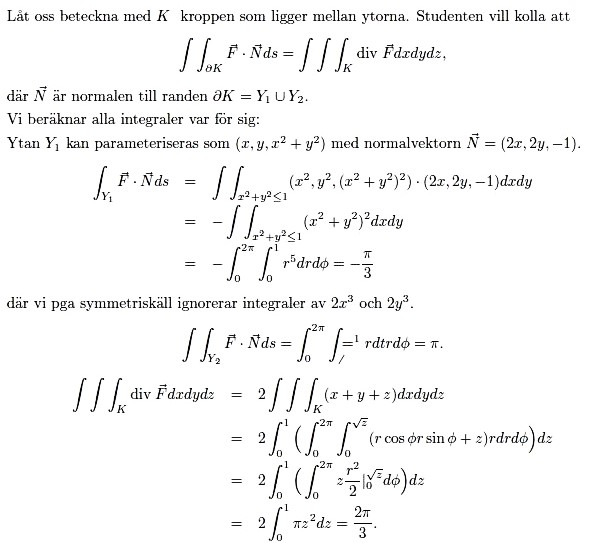

However, the functioning of the brain remained largely a mystery and the only guidance available was largely how head injuries affected certain body functions, as well as the senses and thoughts. War invalids and accident victims who had survived severe head traumas, patients in mental institutions and what could be found through dissections and microscopic examinations of brain tissues, constituted the main clues to how the human brain functioned. Examinations of trauma survivors’ damaged brains came to be called Lesion Studies.

In 1848, Phineas Gage worked as a foreman on a railroad construction site in Vermont, USA. He was known to be a reliable and solid man. A hole filled with gunpowder exploded prematurely and sent an iron spike right through Phineas’ head, destroying his left frontal lobe. Phineas was in a coma for a week, but after waking up he quickly recovered, but by then he had turned into an impulsive, vulgar and generally unpleasant person. Gage lived for another fifteen years, but then as a tragic figure who made a living by allowing himself to be exhibited, with the fatal skewer in hand, at that time very popular Freak Shows.


Gage’s injury caused an ever-increasing interest in how different parts of the brain were essential to certain character traits and how they were connected to other functions, something that led to a revival of the central ideas of 18th -century phrenology.
The term phrenology comes from Greek words for “mind/soul” and “the doctrine of”. It is the German doctor Franz Joseph Gall (1758-1828) who has come to be regarded as founder of phrenology. Gall was an experienced anatomist who argued that the human psyche resides in the brain and does not take the form of a kind of fleeting, non-material soul. Through this finding, he came to the conclusion that different parts of the brain have different functions and that a certain brain centre can vary in size and development in different individuals. His big mistake was the assumption that the brain presses on the inside of the skull and thus affects its shape. According to Gall, a person's personal characteristics could thus be measured by examining the shape of his/her skull.


Inspired by Gall, the Frenchman Jean Pierre Flourens (1794-1867) began in 1815 to cut into the brains of living rabbits and pigeons and carefully investigate whether his interventions affected the animals’ movement patterns, sensitivity and behaviour. He did this to disprove Gall’s opinion that the shape of the skull could reveal which parts of the brain that influenced a certain behaviour. Fluorens was convinced that in order to find behavioural changes, one had to make direct interventions in the brain of living beings. He found, for example, that the removal of the cerebellum affected the animals' sense of balance.


In 1861, the Frenchman Paul Broca (1824-1880) examined a patient in whom a head injury had caused such a severe language disorder that he could only say “tan”. When the man died shortly afterwards, Broca dissected his brain he found that an area in the back part of the left frontal lobe had been badly damaged. This specific location turned out to be a language centre, something Broca managed to prove through surgical interventions on macaque monkeys, which, if they survived, no longer could express themselves through the formation of sounds.

Since then, monkeys have often been victims of nauseating experiments. For example, the American Roger Wolcott Serry (1913-1994) managed to prove that the two different halves of the brain have different functions, partly by studying patients who, in order to alleviate their epilepsy, had had their cerebral cortex (the connection between brain halves) cut open and partly by observing monkeys that deliberately underwent various surgical procedures in the brain.

Experimentation with macaque monkeys is still on-going and makes me think of a scene in Roy Andersson's film A Pigeon Sat on a Branch Reflecting on Existence. In a cold, clinically clean laboratory a live macaque, with a removed braincase, is painfully mounted upon a stand and with electronic equipment connected to its exposed brain, this while a laboratory assistant in the background looks out the window, speaking into her mobile phone while repeating the same phrase over and over again: “So nice to hear that you are doing so well.”

Broca’s experiments was completed by contributions from the German Carl Wernicke (1848-1905). Her worked in a mental hospital where he investigated various forms of aphasia. Aphasia is a disorder affecting speech abilities and language comprehension. Expressive aphasia affects a patient’s speech, making it impossible to find the right words. Impressive aphasia makes it difficult to understand what others are saying. Transfer aphasia involves a loss of motoric control of speech-creating organs.
Broca discovered the the brain’s centre for controlling the mechanics of speech, while Wernicke through autopsies and animal experiments discovered another area of speech and language control. Damage to Wernicke’s area led to fluent but disordered speech, impaired speech comprehension, and messed up silent reading. The area where a damage had occurred determined what form of aphasia the patient developed.


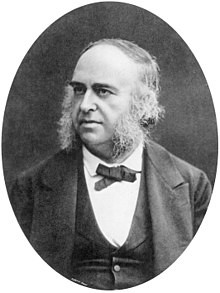
The Italian anatomist Cesare Ezechia Marco Lombroso (1835-1909) was inspired by Gall's theories and conducted comprehensive studies of various skull injuries, which as in survivors like Phineas Gage had caused dramatic personality changes. Lombroso performed and documented a large amount of dissections of deceased criminals and concluded that they were “born criminals” and that that a predisposition for immoral and/or offensive behaviour could be “anatomically defined” through careful documentation of certain characteristics; such as a sloping forehead, unusually large ears, asymmetrical facial features, or pronatism, i.e. that a part of the face, for example the lower jaw, sticks out more than normal, elongated arms, strange skull shapes and a variety of other physical features. During his lifetime, Lombroso was generally hailed as a revolutionary scientist and his vast literary output influenced a host of novelists, such as Zola, Conrad, Ibsen, Strindberg, Tolstoy and Bram Stoker.


Like the fictional Frankenstein and the very real Zheleznyakov, as well as Oppenheimer with the atomic bomb, Lombroso's “research” had terrible consequences. He was a full-fledged misogynist and racist who based his prejudices on dubious “research results” and his huge collection of bones and other human remains. Lombroso's theories, which in fact were quite unsubstantiated, formed the basis for much of the “racial research” that came to form the basis for the Nazi skull measurements and the extermination of Jews, Gypsies, homosexuals, mentally disturbed people who had been hospitalized in asylums, and a host of other people who all had been labelled as "beings with ein Lebensunwertes Leben, a worthless life.”

Unscrupulous scientific charlatans such as Alfred Ploetz, Eugen Fischer, Olmar von Verschuer, Hans Günther, Ernst Rüdin, Robert Ritter, Rudolf Hippius and Josef Mengele contributed through their "research" to the terrible mass murders. In this context might it be recalled that eugenics with a very obvious racist emphasis was a popular research field in many countries with essential contributions from the Englishman Sir Francis Galton and Americans like Theodore Lothrop Stoddard, Charles Davenport, Henri Goddard and Samuel Morton, the French Paul Broca, and not the least Swedes like Magnus Retzius and Herman Lundborg.


A more commendable contribution to brain research was the fact that for eight years Lombroso had Camillo Golgi (1843-1921) as his assistant. After leaving Lombroso, Golgi concentrated on the microscopic study of nerve cells. An invaluable method in the continued exploration of the nervous system was his invented technique of staining nerve tissue with silver nitrate. Thereby he discovered a form of nerve cell which was named Golgi Cell. He was also able to identify the soma/neuron, i.e. the nerve cell body. Through his microscopic investigations, Golgi also found axons and dendrites. Like several other researchers who devoted themselves to microscopic studies, Golgi was a skilled draftsman. As in this drawing showing pituitary neurons:
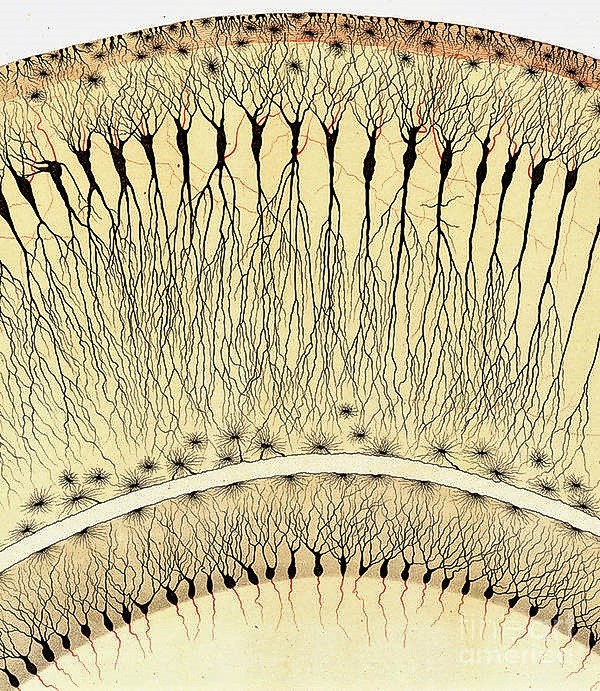
Broca's and Wernicke's discoveries had made it obvious that different parts of the brain work together to create sensations, behaviour, and thoughts, while Golgi's discoveries proved that it was electrochemical connections which enabled cooperation between different parts of the brain and thus the functioning of the entire organ, something that opened the way for investigations of how energy travels through the brain.
Energy is created in the centre of a neuron. Just outside its nucleus we find the mitochondria, small DNA-carrying structures that contribute to energy production, while the cell nucleus is the neuron's control centre. Electrical nerve impulses travel between neurons at a maximum speed of 400 km/h. Electrical impulses pass from neuron to neuron through nerve fibres, axons, often encased in myelin, an insulating fatty substance.


To continue its journey from a sending axon to a receiving dendrite, the nerve impulses must pass a synapse, where the electrical impulse is stimulated to release neurotransmitters, chemical messengers that transmit the electrical current to dendrites that branches out from the cell body of a receiving neuron. In this manner, electrical signals travel from neuron to neuron until they reach their destination.

The researcher who clarified this process was the Spaniard Santiago Ramón y Cajal (1852-1934). Ramón y Cajal had a poetic way of expressing himself. For example, he called neurons “the enigmatic butterflies of the soul whose flapping wings will one day reveal their secrets to us.”
In his memoirs, Ramón y Cajal recounted how, during his somewhat mischievous youth, he witnessed a ghastly accident that, according to him, became a watershed for him, setting him on a path that resulted in significant scientific achievements and a Nobel Prize, namely the discovery of the functions of neurons, their crucial role in the transmission of life-giving electricity throughout the body.

A priest, startled by a violent storm, had rushed up the bell tower of the village church and, in a futile attempt to appease God’s wrath, he had begun tolling the bell. However, lightning struck the tower and the young Ramón y Cajal witnessed how
under the bell, enveloped in dense smoke, with his head hanging lifelessly over the wall, lay the poor priest, who thought he could avert the impending danger by a careless ringing of the church bell. Several men climbed up to help him and found him with his clothes on fire and with a terrible wound on his neck, from which he died a few days later. The lightning had gone straight through him and maimed him in a terrible way.

Ramón y Cajal's aesthetic/poetic streak appears in his drawings and writings. He was for most of his life an agnostic who lamented that he was not a devout Catholic, but as he grew older he began to perceive God’s presence in His creation, though he maintained his experimental/empirical sense .

Aesthetics was something Ramón y Cajal shared with another eminent neurophysiologist – the Englishman Charles Scott Sherrington (1857-1952) who fine-tuned Ramón y Cajal’s discoveries about the brain’s energy transfer and coined the term synapse. In his book Man On His Nature, Sherrington writes about the miracle of everyday life, how the brain’s energy is connected to the vastness of the universe:
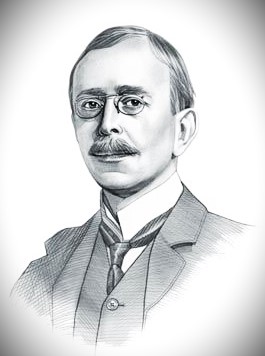

The brain is waking and with it the mind is returning. It is as if the Milky Way entered upon some cosmic dance . Swiftly the head mass becomes an enchanted loom where millions of flashing shuttles weave a dissolving pattern, always a meaningful pattern though never an abiding one; a shifting harmony of subpatterns. Now as the waking body rouses, subpatterns of this great harmony of activity stretch down into the unlit tracks of the stalk-piece of the scheme. Strings of flashing and travelling sparks engage the lengths of it. This means that the body is up and rises to meet its waking day.

Sherrington writes about the researcher’s joy and excitement while confronting the mysteries of the Universe and the body. He fears that this childish wonder before the beauty and mystery of existence will eventually disappear:
We dismiss wonder commonly with childhood. Much later, when life’s pace has slackened, wonder may return. The mind then may find so much inviting wonder the whole world becomes wonderful. Then one thing is scarcely more wonderful than is another. But, greatest wonder, our wonder soon lapses. A rainbow every morning who would pause to look at? The wonderful which comes often or is plentifully about us is soon taken for granted. That is practical enough. It allows us to get on with life. But it may stultify if it cannot on occasion be thrown off. To recapture now and then childhood’s wonder, is to secure a driving force for occasional grown-up thoughts.

Ramón y Cajal's search for the mechanical structures and energy behind our thinking seems to have a similar physical basis for assumptions and research as the German Hermann von Helmholtz. (1821-1894), a brilliant scientist and inventor with a surprising breadth of research. A versatile medical doctor, physicist, inventor and philosopher who tried to find explanations for how our minds work and how energy can be stored and forwarded.

To explore the function of the eye and the emergence of the sense of colour, he invented the ophthalmoscope, which made it possible to look into the interior of the eye, diagnose eye diseases and prevent blindness, and the keratometer, which measured the refractive power of the cornea.


To study the psychology of acoustics and our perception of sound, he constructed a sound synthesizer: ten electromagnetically charged tuning forks, each paired with a brass resonator tuned to the same frequency. This he did to demonstrate and analyse the effect of harmonics in complex sounds. One of his goals was to better understand the nature of speech and the production of vocal sounds, produced by resonant harmonics and mechanically created by muscles of the vocal tract. von Helmholtz also constructed several simpler and elegant resonators, which he used to identify different frequencies.


In physics, von Heimholtz is known for his theories concerning energy conservation, electrodynamics, chemical thermodynamics and the mechanical basis of thermodynamics. As a philosopher, he wrote about the relationship between perception and natural laws, about science as aesthetics and civilizing force. His writings deal with the indestructibility of energy/force, about the unity of forces and force transformation. They range from the age of the Earth to the origin and fate of the solar system.
According to von Helmholtz, the brain is a kind of "probability machine", which, through data carried by energy, use complex feedback mechanisms to control, adjust and minimize various inaccuracies, misconceptions and incomplete information conveyed through our senses.
von Helmholtz described himself as an “experimental philosopher”. He believed that our perception of objects and phenomena that surround us is the product of how our sense organs perceive them and how our consciousness processes that information. Our conceptions do not depict things as they actually exist outside of us, they are merely signs or symbols of them. However, we are able to form an idea of the true nature and existence of things by examining the laws and physical functions that govern our thoughts and sensations.

Below is a drawing by Ramón y Cajal showing neurons in the grey matter of the cerebral cortex (though in a living brain it is most likely dark pink. It is when the cerebral cortex is stored in a laboratory that it turns grey).

The cerebral cortex brings us back to Swedenborg’s speculations about the seat of the soul, mainly his opinion that all nerve fibres of the brain were connected to the cerebral cortex’s myriads of cerebellula, the small glands that Swedenborg assumed were concentrated in the pituitary gland and the grey cerebral cortex. Gland structures which task it was to separate and mix different chemical signal fluids.

In fact, the grey matter of the cerebral cortex consists of neuron cells which root-like excrescences, axons and dendrins, form the white brain matter that handles communication between the body's nerve cells. Swedenborg was not entirely lost when he assumed that the cerebral cortex was the seat of the soul. The 3–5 mm thick, folded cerebral cortex is more developed in humans than in any other mammal. Elephants have larger brains than humans, birds have larger brains relative to their body weight ratio, and whales have more folds in their cerebral cortex, but the human cerebral cortex has the most neurons and more functions than any animal brain. Swedenborg was absolutely right when he assumed that the cerebral cortex is involved in several of the brain's complex functions; such as memory, attention, thinking and language.

Like Hermann von Helmholtz, the American neurology professor David Linden appears to assume that the human brain is a “probability machine” that weaves together sophisticated, nut nevertheless flawed, information from sensory impressions into coherent interpretations and “stories”. This cognitive function is mainly located to the left, frontal cerebral cortex and it is this part of the human brain that creates our self-consciousness , which distinguishes us from other animals. It is this part of the brain that forms the basis for dreams, as well as the creation and sharing of all kinds of uniquely human thoughts and behaviour, not least in the religious sphere.
Religion is a form of personal belief that is influenced by sociocultural factors, our common human evolutionary heritage as reflected in the structure and function of our brains, which predisposes us to religious thinking in much the same way that it predisposes us to other cultural universals, such as long-standing pair bonding, language and music.

In his book The Accidental Mind, Professor Linden described the human brain as a
A chaotic patchwork. Admittedly impressive through its various functions, but with an odd, inefficient and bizarre design. A strange concoction accumulated over millions of years through ad hoc solutions,
Linden compares the human brain to an ice cream cone, in which scoops of different flavours have been stacked on top of each other. Evolution has added brain functions, which like scoops of ice cream have ended up on top of lower strata that largely have remained unchanged.

A human's brainstem, cerebellum and midbrain are not that different from a frog’s. However, evolution added the hypothalamus, thalamus and the limbic system, brain parts that are also found in a rat. What makes humans unique is their well-developed cortex, the cerebral cortex, the size of which means that it has shrunk and becoming increasingly folded to fit in under the shell of the skull.
The human frontal cortex is particularly sophisticated. This part, which is crucial to human uniqueness, constitutes the associative centre of the brain; it fills in information gaps and creates context and logic, even when there is none of it. In this frontal cortex we find the origin of fantasy, creativity, storytelling and gossiping, all of them exclusive human traits.

Thoughts and behaviour arise within different brain centres and it is a multitude of nerve connections and electrochemical currents that travel through them that convey and create sensory impressions, while it is primarily the task of the cerebral cortex to monitor and interpret this swarm of information.
Most functions and processes can be found in both sides of the brain. However, there are certain functions that are mainly localized to one of the two brain hemispheres. The left hemisphere contains language functions, such as speech and writing, several of them connected to the previously mentioned Broca and Wernicke areas. Information from the cerebral hemispheres are connected and coordinated via the Corpus Callosum.
In popular literature, the exclusive functions of each of the cerebral hemispheres are often exaggerated. Studies of people who have had the connection between them severed, for example by a surgical separating of the halves (generally to mitigate or cure epilepsy), have indicated that the left hemisphere of the brain coordinates abstract thinking; such as the meaning and context of words, as well as sequential mathematical calculation. The right cerebral cortex is more concentrated on spatial concepts and relationships. It contributes to detection of the emotional tone of words, relates to music and interprets subtle facial expressions.

In 1996, American neuroscientist Jill Bolte Taylor suffered a massive brain haemorrhage that filled her left brain hemisphere with blood, knocking out a variety of functions. She lost the ability to walk, speak, write and read, suffered from large memory gaps and problems with the coordination of her body movements. After a surgical procedure and eight years of intensive training, Bolte Taylor managed to reconstruct what she had lost through her impaired brain functions.
In her book My Stroke of Insight, she described in great detail the entire process of tribulation and recovery, from the morning she woke up, confused and disabled by a violent brain haemorrhage, caused by a ruptured blood vessel. Free-flowing blood poses a deadly danger to the brain’s neurons, and the emergency becomes even more fatal when the blood coagulates and creates massive clots.

The strange thing was that Bolte Taylor, despite her inability to speak intelligibly and countless other difficulties, she experienced what in other times could have been considered mystical ecstasy: "in the absence of sight, sound, touch, smell, taste and fear, I felt how my spirit left its attachment to my body and I was freed from the pain.”
Instead of panicking at her helpless state, Bolte Taylor felt calm and peaceful, as if she had "united with the universe." She writes that "I believe that the experience of Nirvana rests in the consciousness of our right hemisphere", by Nirvana Bolte Taylor meant "the absence of experiences".

She explained that before her stroke, her disciplinary and logical left hemisphere created in her a sense of permanent nervousness, yes – she had often been both mean and unkind to herself and others. During her impotent submission to the right hemisphere, she empathized with all beings. Without understanding the meaning of words, she noticed the emotions that shaped them and the facial expressions accompanying them. Without structure, discipline and censorship, her thoughts moved freely and unfettered, effortless but also without comprehensibility. When she was restored and with the help of the left hemisphere gradually had become able to organize her thoughts, rediscover her place in the world and shape her experiences into a “story”. Bolte Taylor eventually realized the value of the right hemisphere’s contribution to the human psyche. Her book shaped itself into a hymn to the right hemisphere of the brain:
My right mind character is adventurous, celebrative of abundance and socially adept. It is sensitive to nonverbal communication, emphatic and accurately decodes emotion. My right mind is open to the eternal flux whereby I exist with the universe. […] It is my intuition and higher consciousness. My right mind is ever present and gets lost in time. [...] Not bogged down by my past or fearful of what the future may or may not bring.[…] My right mind understand that I am the life force power of the fifty trillion molecular geniuses creating my form!

Here we find, although not as impressive as it is with them, a reflection of Whitman’s celebration of the unity of body and soul and Södergran’s triumph of existence. Like Swedenborg, who was also an educated and skilled explorer of the mysteries of the brain, Bolte Taylor, through her painful and upsetting brain haemorrhage, appeared to have opened her mind to a mystical vision of the vastness and innermost essence of existence. Nevertheless, I could not help nurturing a suspicion that Bolte Taylor’s praise of her right brain hemisphere was moving in direction towards a quite banal New Age philosophy.

My fears about where Bolte Tylor was heading appeared to be confirmed by her next book, Whole Brain Living. In it she presents, in Jungian succession, four “characters” based on different locations in the brain. If Jung moved among myths, Bolte Taylor moves within ”science”, meaning her own personal perception of it.

Bolte Taylor’s version of Cosmic Consciousness and our place within it appears to be, at least for me, blatantly naïve and oversimplified. Her four characters seem to reflect a personality analysis flavoured with a horoscope’s description of the zodiac’s predisposition to human traits. According to Bolte Taylor, the Persona (or hero) has its seat in the front left part of the brain. The Shadow lurks in the back left part. Anima/Animus is found in the back right part of the brain and God, or the manifestation of the Self, is found in the brain’s frontal right part.
Especially Bolte Taylor's definition of her “fourth character” appears to be exceedingly shallow and almost embarrassingly horoscope-esoteric:
Our character 4 is the omniscient intelligence in which we find our origin and it is through it that we incarnate the consciousness of the universe.


Bolte Taylor advocates a seemingly “dogmatic” pantheistically tinged, religious worldview while urging his reader “to use whatever language is convenient for your belief system.” Bolte Taylor also recommends what she refers to as a her “brain cure”. A tool that brings together the four characters of the brain in a conversation that enables us to use their respective strengths in order to be able to choose which character should be embodied in a particular situation.

Bolte Taylor’s mix of science and religion made me think of one of Chesterton’s Father Brown Stories in which the religious detective identifies the culprit as a fake priest. Then the revealed thief asks the real priest how was able to do it, Father Brown states that his ideas exposed him as a fake:
“What?”” the dumbfounded thief asks.
“You attacked reason,” Father Brown replies. “It’s bad theology.”

It is a human trait to seek simple solutions to complicated issues. Not least the complicated questions of – Who am I? Where do I come from? Where am I going? How will my life turn out? Life is in fact, with Thomas Bernhard’s ingenious phrase, “simply complicated”. To avoid difficulties, one can therefore take refuge in a horoscope’s personality characteristics and predictions, or why not Thomas Eriksson’s best-selling book Surrounded by Idiots. It was published in 2014 and it has since then been used in recruitment processes and life skills courses. In Sweden alone it was purchased by more than half a million. An interesting title, but unfortunately a bad book.

Thomas Eriksson divides people in accordance with four categories – “dominant, inspiring, stable and analytical.” Each category is designated by a colour; red, yellow, green and blue.

The approach is well known, this so-called “DISC-method” has for several decades been successfully used by various consulting firms. It finds its origin in the book Emotions of Normal People, which was written in 1928 by the psychologist William Moulton Marston (1893-1947).

Marston was a multi-tasker who, in addition to books on self-help and psychiatry, together with Leonard Keeler participated in the development of the polygraph, somewhat incorrectly called a lie detector. A device that measures and records physiological indicators such as blood pressure, pulse, respiration and skin conductivity, while a person is asked and answers a series of questions. Marston's contribution was the measurement of the systolic blood pressure. Systolic pressure indicates the force vessel walls are subjected to as the heart contracts and pushes a volume of blood into the body. Marston had observed his wife Elizabeth and ascertained that “when she became angry or excited, her blood pressure seemed to rise alarmingly.”
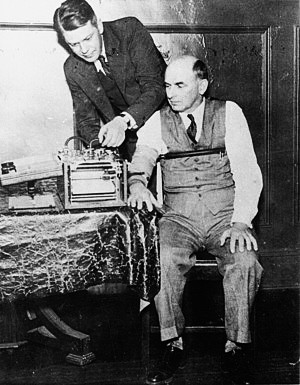
The belief underlying the use of a polygraph is that misleading/false answers produce specific physiological responses. However, most psychologists agree that there is little evidence that polygraph tests might conclusively detect lies. However, lie detectors in the form of so-called e-meters have a decisive function within the Scientology religion, which was founded by the charlatan and science fiction writer L. Ron Hubbard.

Polygraphs are still used fairly widely in the United States, but in a majority of European jurisdictions consider them to be unreliable and there they are rarely used by law enforcement. In addition to DISC therapy and polygraphs, Marston is known to have been “poly-amorous”. He lived in an open relationship with two women and had two children with each of them. A third woman occasionally joined Marston’s Rainbow Family. This has among advocates of so-called “rainbow marriages” made Marston something of a cult figure and in a film from 2017, Professor Marston and the Wonder Woman, Marston and his two wives are the heroes. The film also celebrates how Marston created the comic book character Wonder Woman.

Let us now leave the pseudo-sciences and confront the remarkable phenomena that the use of magneto-encephalography (MEG) apparatus has given rise to. A new world is opening; incomprehensible, wondrous and maybe even terrifying.

Neurons use oxygen that is transported through the bloodstream by haemoglobin molecules. Haemoglobin contains iron. The magnets in an MEG device track iron in the brain and magnetic impulses can thereby signal when different parts of the brain have become active. This happens by sending additional oxygen-carrying blood into them, thereby creating visible contrasts between active and inactive states.
In 2009, brain researchers in Liège discovered that a patient, who, after a brain injury, was in a vegetative state, unable to communicate with the environment, actually had several active thought functions. After being brought into an MEG machine, the patient was asked if he could imagine himself walking around in a house. The question made a certain area of the brain light up. When he was asked to imagine that he was playing tennis, a completely different part of the brain was activated. The researchers then asked him to use the thought “play tennis” as a signal for “yes” and asked him if his name was “Alexander” – the “tennis area” was lit up. They then asked him to imagine “wandering around in a house” would signify a “no”. He was then asked if he had any sisters, the “house area” was lit up, and so on until a conversation could be built around yes and no answers. Sometimes a question did not get a clear answer, for example when the researchers asked Alexander if he wanted to die. Through this method, the Belgian researcher team came to estimate that twenty per cent of patients assumed to be in a “vegetative” state, actually were conscious.

Artificial Intelligence (AI) and brain scanning are rapidly changing researchers’ ability to read neural data. Through mathematical thinking based on algorithms, i.e. those finite sets of data are by means of unambiguous instructions run through computer programs; several researchers now believe that they are approaching the origins of human thoughts and mind. The amount of possible thoughts that people can think is large - but it is not infinite, and with the help of scanners and AI, researchers are now searching among brain neurons to identify specific patterns and “activation codes”. What so far has been found are so-called voxels – “activation areas” that are approximately one cubic millimetre in size. The breakthrough came when researchers figured out how to use MEG and computers to track tens of thousands of voxels at a time and then manage to activate them as if they were keys on a piano and as thoughts were chords. With the help of computer technology, a visual and semantic space can be created, probably a path towards the understanding of how our brains reflect the world.
Researchers’ are attempting to capture the constant flow of voxel patterns and then process it through colour and sound interpretations similar to those the brain applies to sensory impressions and thoughts. By analysing brain scans, a computer system can edit reconstructions of film clips that a subject has seen and afterwards stored among their brain windings. A research group has used similar techniques to visually reconstruct/mirror the dreams of sleeping subjects.

It sounds farfetched, or completely impossible, but we might consider how in 1953 Watson and Crick finally found the Double Helix they had been looking for during several years and thus proved that genes actually had a physical form. Already by the end of the 20th century, The Human Genome Project was able to present the complete DNA sequence of Homo Sapiens. Today, they can even edit it.

Bold thinking, fantastic plans and yet in a cosmic perspective I is like little Calvin playing in his sandbox.

To me it appears as if the Universe and thus also human brains are animated by a cosmic force. Maybe several. What do I know?
The Greek energeia meant “activity”, from energos, “active”, where en stands for “in” and ergon for “work”, so energy can actually be translated as “in work”. For many scientists, the search for a cosmic energy has turned to be an enormous and exhausting task. Frankenstein dreamed of finding the origin of life and thereby becoming like a creative god – but he created a monster. Lombroso believed that by measuring an enormous amount of skulls and in detail observes a person’s appearance, he could determine who had criminal tendencies, or even who was simply a genius. The result of his “research” became one of the reasons for the Nazis' insane mass extermination of “useless” and/or “harmful” people. The driving force behind all this? Is it the electricity that flows through our brains? How did Hitler’s brain function? Which brain centres would his Jew-hatred light up if he had been put into an MEG scanner? How does Putin’s brain function?
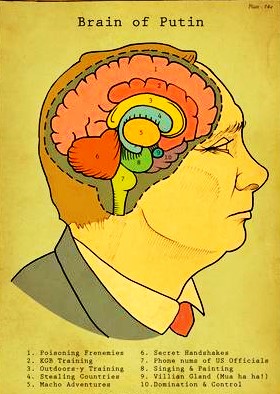
A milestone in neuroscience was Oskar Voigt's careful study of Lenin's brain, which in 1924, and at the request of the Soviet government, was carried out at the Kaiser Wilhelm Institute in Berlin. Vogt’s detailed and well-documented research has been praised for highlighting the role of neuroscience in understanding human behaviour and the complex interplay between biology and environment. However, over time it has turned out that Voigt’s conclusions in reality was almost without any scientific proof. Professor Vogt’s assumption that Lenin was a “brain athlete and an associative giant” is quite doubtful. It was a dead brain Voigt dissected and microscopically examined and it was thus impossible for Vogt to establish which different brain centres that had been activated by electrochemical processes triggered by Lenin’s thoughts.

Statements about Lenin's “intelligence” should furthermore take into account his aptitude for generalization and a willingness to use violence and terror, paired with an obvious, cold lack of empathy. Something that often came up when different people described their meetings with him. For example, Bertrand Russell who in 1920 had a more than hour-long, private conversation with the Soviet leader:
He laughs a lot; at first his laugh seemed merely friendly and cheerful, but by and by I came to find it rather harsh and grim. He is dictatorial, calm, fearless, completely lacking in self-awareness, a theory embodied. He perceives the materialistic conception of history as his lifeblood. In his desire to have his theories understood, he resembles a professor, and so also in his fury towards those who misunderstand or disagree with him, as well as his propensity to explain. I got the impression that he despises a great many people, that he is an intellectual aristocrat.

Lenin's orders and letters often indicate a brutal ruthlessness, for example when he in 1921 in a letter to one group of his 200 000 chekists, henchmen enforcing his branch of Communism, wrote:
It is necessary – secretly and urgently to prepare the terror. […] make sure that the hangings takes place in full view of the people, [hang] no fewer than one hundred known landlords, rich men, and bloodsuckers. ... Do it in such a fashion that for hundreds of kilometres around, the people might see, tremble, know, and shout: “They are strangling, and will strangle to death, the bloodsucking kulaks.

We have among as contemporary Frankensteins who do not hesitate to perform the most fantastic experiments on living people. Sergio Canavero (born 1964) worked for 22 years as a neurosurgeon in Turin until his contract was terminated in February 2015, due to increased opposition to his research. After his dismissal, Canavero was named honorary professor at Harbin Medical University, where he now collaborates with Xiaoping Ren. In January 2016, Canavero and his team published a press release announcing a “successful head transplant” on a monkey, which survived the procedure and was kept alive for 20 hours. The press release mentioned that Canavero and his Chinese colleagues are now experimenting on human cadavers and that they are confident that within a few years they will be able to perform successful human head transplants.


Are we humans transgressing the limits set by the cosmic energy/balance? There is no doubt that each and every one of us is connected with everything. When cosmic radiation was discovered a hundred years ago, a new field of research was opened, particle physics, and with it, studies of the origin of matter and its innermost structure. Modern physics thus got its start and brain research became part of it. Everything in the universe shares the same microscopic building blocks – molecules, atoms, quarks and bosons and the same force/s set everything in motion.
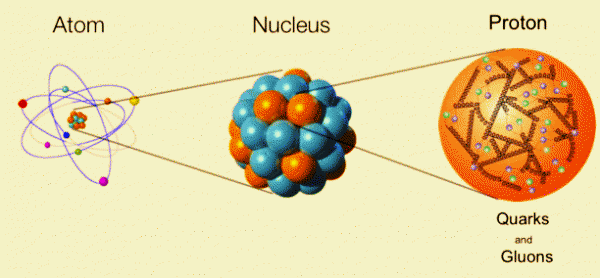
The discovery of so-called cosmic radiation began at 6:00 a.m. on August 7, 1912. Then a 1,700 cubic meter balloon, filled with hydrogen gas, took off from Aussig, a town between Prague and Dresden. In the gondola were the 29-year-old Austrian Victor Hess as well as two colleagues and several instruments with which they intended to measure the production of electric charge, the ionization, in the higher air spaces.
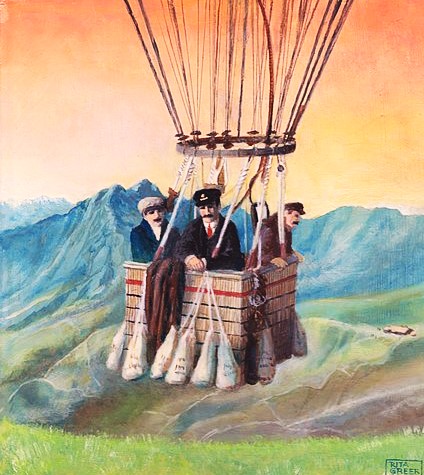
The balloon reached an altitude of 5,000 meters and on the way there Hess measured how the ionization of the air varied with altitude. To his great surprise, he found that it was almost three times higher than on the ground. It was the opposite of what he and other researchers had expected. Since the beginning of the 20th century, the penetrating radiation had been a mystery. It was assumed that the air was charged by the radioactive radiation of the earth's crust, and therefore the ionization should decrease with height above the ground. That was not at all the case.
To the surprise of many, it turned out that the vast vacuum of space between planets, suns and galaxies was far from empty. The earth is continuously bombarded by various forms of energy/cosmic radiation and contrary to what was believed before Hess's discovery, cosmic radiation consists for the most part of positively charged particles. Today we know that nearly nine out of ten of incoming cosmic particles are protons.
Cosmic rays are high-energy particles that move through space at close to the speed of light. They originate from the sun and also come from our own galaxy, as well as from more distant galaxies. Galactic, cosmic rays arise from supernova remnants. They are the result of the powerful explosions taking place during the final stages of massive stars’ final demise, or collapse into black holes. The energy released by such explosions accelerates in the form of charged particles. Supernovae are like huge, natural particle accelerators.
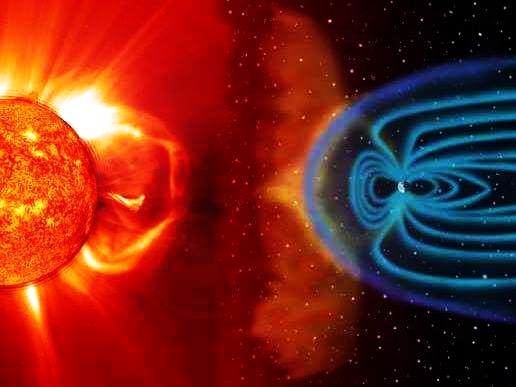
Using quantum field theory, the so-called standard model of particle physics describes the smallest particles and how their interaction creates the four elementary forces that govern the Universe. Gravity which controls the orbits of the planets around the sun and binds stars together into galaxies. Electromagnetism connects the electrons to the atoms and is the force that, through chemical connections, gathers molecules into DNA chains. The Weak Interaction produces radioactive decay, while the Strong Interaction forces protons and neutrons to form atomic nuclei.
In school I learned that an atom resembles a planetary system. Its nucleus is like a sun in the middle and negatively charged electrons revolve around the positively charged atomic nucleus.

It is a model that Niels Bohr introduced in 1913. However, according to him, it was more complicated than that. Unlike how planets move, the electrons are thought to be able to jump between orbits. If they jump from an outer orbit to an inner one, a flash of electromagnetic radiation is emitted from the atom. If the atom is struck by such lightning, it may occur that an electron is lifted from an inner to an outer orbit.
Because of its clarity, Bohr’s atomic model continues to be the one that many physicists and chemists have in mind when they do their mathematical calculations. But it is supplemented and complicated by quantum mechanics, where one imagines that the positively charged atomic nucleus is surrounded by a cloud of negative charge. The cloud can change its shape by sending out or receiving electromagnetic radiation.

Electrons constitute a kind of force field. The protons and neutrons of the atomic nucleus, as well as the circling electrons, have been proven to consist of even smaller parts and they are now assumed to together form a group of particles called hadrons. A hadron contains elementary particles that aggregate into something called quarks and leptons.
There are two forms of hadrons – baryons which are constituted by three quarks and mesons, which are made up of one quark and one antiquark. According to the Standard Model, it is force-carrying elementary particles within the quarks that mediate the four fundamental forces of nature. These particles have been identified as photons, gluons, bosons and so far hypothetical gravitons. It is their interaction that creates energy, mass and electrochemical charge.
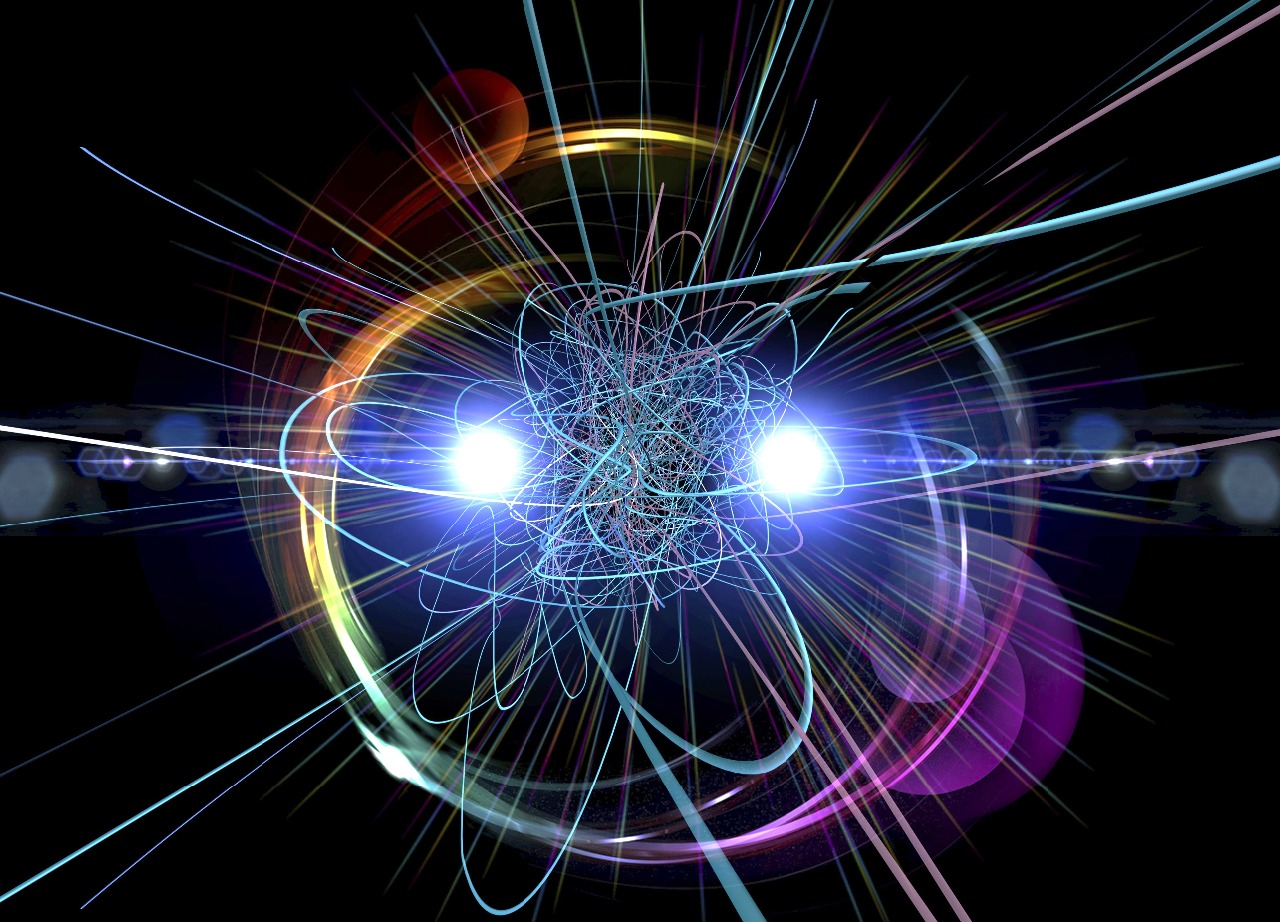
Physicists hope that there will be a “theory of everything” that includes the four elementary forces and thus will be the solution to the Standard Model's many unanswered questions. Perhaps the newly identified Higgs Boson could be a decisive step in that direction.
Several particle designations are named after their discoverers, their function, or are simply made up. For example, Murray Gell-Mann searched for a name for the particle bonds he discovered. In his book The Quark and the Jaguar: Adventure in the Simple and the Complex, Gell-Mann describes how in 1964 he repeatedly heard the word kwork within himself. He had read it somewhere and finally found it in a poem in James Joyce’s quite incomprehensible Finnegan’s Wake:
Three quarks for Muster Mark!
Sure hasn't got much of bark
And sure any he has it’s all beside the mark.

Apparently, this piece of incomprehensibility refers to the drunken chatter in a pub where someone orders three pints of beer for someone called Mark. A quarter is two pints of beer. Gell-Mann was very pleased with his word discovery because “the recipe for making a neutron or proton from quarks is, roughly speaking, 'take three quarks'.”

Bosons are named after the Indian mathematician and physicist Satyendra Nayh Bose (1894-1974). He was a universal genius, spoke Bengali, English, French and German, and read Sanskrit fluently. The latter made Bose read Hindu religious scriptures with great interest. Like many mathematicians and physicists, Bose was musically gifted and known as an accomplished esrai musician, the esrai is a Punjabi stringed instrument likened to a violin.

Among other things, Bose worked with extremely complicated mathematical analyses of the connection between supposed elementary particles and came to the conclusion that what came to be called bosons are separate from the infinite number of particles that can simultaneously have the same state, which means that at the lowest energy level they can be clumped together, This seemed to support a notion of a kind of cosmic symmetry based on “fields” that pervade the entire Universe. These particles can at different points in time and space assume different values, depending on the average number of particles that can be observed within the field. Particles can be created and destroyed by adding or removing energy from the field. Every known particle, from electrons to photons, is associated with a space-time saturated vibrating field.
I'm neither a physicist, nor a mathematician and can certainly have misapprehended everything. Nevertheless, I suppose that Bose’s discoveries and theories suggested that conditions for“electroweak¨” symmetry could be changed by the presence of a different “field”. The building blocks of such a field could be the particles which existence Bose suspected.
We can assume that a particle named fermion (after the Italian physicist Enrico Fermi) is the prerequisite for the origin of the constituents of our existence. Yes, the entire Universe – electrons, quarks, protons, neutrons, etc., this while the bosons are forces that make them vibrate together. According to the Standard Model, the weak force and the electromagnetic force are combined into a single force, called the Electroweak Force. At high energies the Weak Force and the Electromagnetic Force are different aspects of the same force, but at lower energies they separate into different force fields. This happens through a so-called Spontaneous Symmetry Break caused by a specific boson. A connection assumed by Satyendra Bose.

In an article Bose published in 1924, he presented a summary of his research findings. He sent it to Einstein, who was impressed and found Bose's theories completely consistent with his own hunches. He translated the article into German and saw to it that it was published in the respected Zeitschrift für Physik.

Several years later, independently of each other, Peter Higgs and François Englert/Robert Brout presented in 1964 a theory that assumed that the W-, Z+- and Z bosons, which make up the Electroweak Force, obtain their masses through a Spontaneous Symmetry Break caused by what is now called the Higgs Mechanism, in which a boson – the Higgs Boson – plays a crucial role.
At high temperatures, four bosons jointly mediate the Electroweak Force. However, at low temperatures, three bosons combine themselves with each other, while the fourth, which is now called the Higgs Boson, is left entirely alone. It was the particle that Higgs, Englert and Brout were looking for.


The three researchers had arrived at their conclusion through mathematical analysis. Now it was a matter of proving that the Higgs Boson really existed, as was the case with the Double Helix. It took fifty years before their hypothesis could be proven. In order to do that, it was necessary to use the world's most advanced machine – the giant particle accelerator Large Hadron Collider at CERN outside Geneva. It is a 27 kilometre long circular construction. With the help of 1,200 magnets cooled to -271 degrees Celsius, protons are accelerated to 99.99998 per cent of the speed of light. When the protons collide, the situation just after the Big Bang is to some extent recreated. However, finding the Higgs Boson is extremely rare. Out of a billion proton collisions, possibly 10 Higgs Bosons can be observed. Not only that – the Higgs Boson decays almost immediately. At a seminar at Cern on July 4th, 2012, it was announced that the sought-after boson had been found.

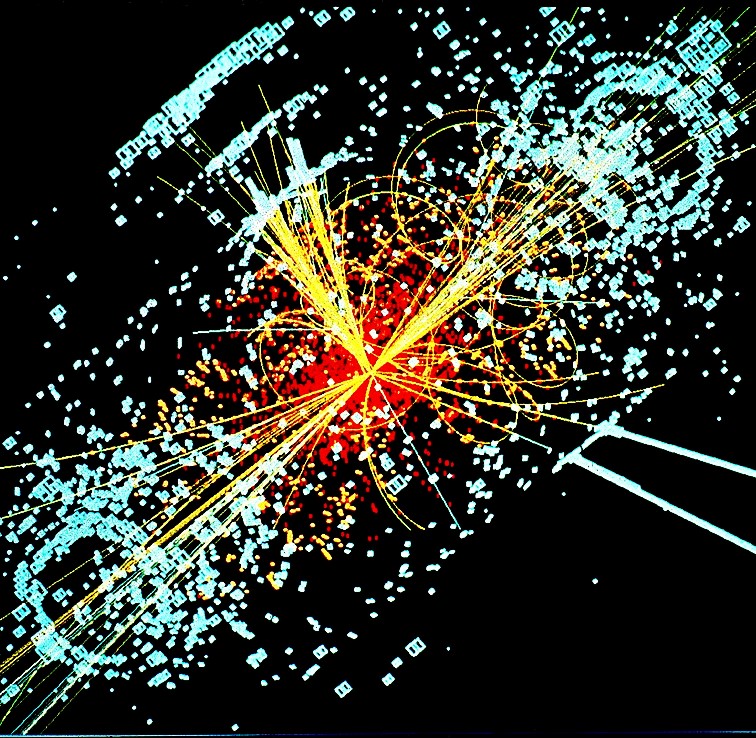
Within the mist of my compact ignorance it seems to me that nuclear scientists are actually approaching something that could be a proof of the presence of a single, all-unifying, cosmic force that permeates the entire universe including us humans. A force that obviously cannot disappear as long as Cosmos exists. And in the midst of this cosmic vastness are you and I, with our big problems, our limitations, our mood swings, evil and goodness, our intractable traumas and crazy ideas. Our puny existence, our small egos and limited consciousness, which after all are made up of the same atoms and forces as the incomprehensibly vast Universe we are all a part of, with its swirling planets, suns and galaxies, all of which are so unimaginably far away from us and our everyday existence.

When I read about these breath-taking perspectives where electrically charged particles contribute to the creation of the human brain and the constant flow of information that gives rise to our thoughts and our special personality, it is easy to forget the battle between sociology and medical materialism, i.e. environment and heritage. In my opinion, these concepts are not at all in opposition to each other. I assume that a large part of the evolutionary ice cream that David Linden writes about contains a large dose of ever-changing experiences, of what we learned from parents, friends, enemies, acquaintances and social media. What we call nature is a prerequisite for what we call culture.
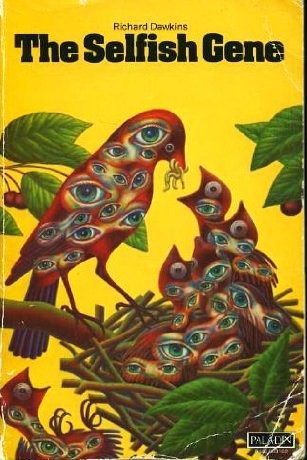
In his book The Selfish Gene, the British evolutionary biologist Richard Dawkins (1941-) introduced the concept of meme. A meme is generally described as
an element of a culture or system of behaviour passed from one individual to another by imitation, or other non-genetic means.a
As examples of memes, Dawkins gave melodies, slogans, beliefs, fashion, special production techniques, art, etc. According to him, the body and brain act as carriers of both genes and memes. It is genes and memes that make up the biologically and culturally based units that control every part of the human body and thus also the brain. Genes are transmitted through DNA, while memes are spread through transmission from individual to individual; through our senses, our sight and our speech, social media and all other forms of communication that we humans use. According to Dawkins, we humans are herd animals and thus we pay attention to and adapt to cultural and social codes. It is our brains that are attracted to and imitate various forms of information, which then are relayed to our body and consciousness in the form of electrochemical impulses.
Already existing knowledge and skills, behaviour and ideas, are taken over from other individuals and used with the same obviousness as when I in a supermarket put goods in my shopping cart. It is our more or less conscious choices that govern us and it is therefore important to realize that what we call our knowledge and intelligence has emerged from certain specific contexts – family, school, work, interests. In order to realize who we are and how we react, we should probably understand and accept how much of what we believe to be our personality, our consciousness, has been created through collective actions and public information.

Can forces like the transforming Higgs Boson, as many amateurs have done, be likened to God’s presence in His Universe? What do I know? I can possibly refer to what the bishop Jacob, played by Max von Sydow, declares in Enskilda samtal, Private Conversations, a TV series in two parts directed by Liv Ullman and based on a script by Ingmar Bergman that was presented by Swedish Television in 1996
Anna: Do you, Uncle Jacob, believe in God, a father in Heaven, a, ... a loving God? A God with hands and heart and watchful eyes.
Jacob: Don't say the word God. Say the Holy, in every man there is the Holy, the holiness of man, all else is attribute ... manifestations, measures. You can never figure out or capture the holiness of man. At the same time, there is something to cling to, something very concrete unto death, what happens afterwards, it is hidden, it is only the poets and musicians and saints who have handed us mirrors where we can discern the unimaginable. They have seen and known and understood, not completely but in pieces. For me, it is comforting to think about the sanctity of man.

Visionaries like Swedenborg and the strangely brilliant William Blake, mystic, artist, and writer, have each in his manner tackled man’s relationship to his own existence and the immensity of the Universe. In my opinion, Blake did it best in a few short lines:
To see a World in a grain of sand,
And a Heaven in a wild flower,
Hold Infinity in the palm of your hand,
And Eternity in an hour.

Ackroyd, Peter (2008) The Casebook of Victor Frankenstein. London: Chatto & Windus. Barbone, Julia (ed) (2019) Leonardo da Vinci: A mind in motion. London: British Library. Bolte Taylor, Jill (2009) My Stroke of Insight: A Brain Scientist's Personal Journey. London: Hodder & Stoughton. Chesterton, C.K. (2012) The Complete Father Brown Stories. London: Penguin Classics. Crane, Stephen (2005) The Red Badge of Courage and Other Stories. London: Penguin Classics. Darnton, Robert (1968) Mesmerism and the End of Enkightenment in France. Cambridge MA: Harvard University Press. Dawkins, Richard (1978) The Selfish Gene. Boulder, Colorado: Paladin. Ehrlich, Benjamin (2022) The Brain in Search of Itself: Santiago Ramón y Cajal and the Story of the Neuron. New York: Farrrar, Straus and Giroux. Enquist, Per Olov (1989) The Magnetist’s Fifth Winter. London: Quartet Books. Eriksson, Thomas (2019) Surrounded by Idiots: The Four Types of Human Behavior and How to Effectively Communicate with Each in Business (and in Life). New York: St Martins Essentials. Ering, Thomas Basil (1997) Diary of Victor Frankenstein. London: Dorling Kindersley. Ginsberg, Allen (1999) Meditation Rock (CD). Lund: Bakhåll. Gordh, Torsten E., William G.P. Mair och Patrick Sourander (2007) “Swedenborg, Linnaeus and Brain Research – and the Roles of Gustaf Retzius and Alfred Stroh in the Rediscovery of Swedenborg’s Manuscripts,” in Upsala Journal of Medical Sciences, No. 112. Gould, Stephen Jay (1996) The Mismeasure of Man. New York: W.W. Norton.Grayling, Anthony Clifford (2022) The Frontiers of Knowledge: What We Know about Science, History and the Mind. London: Penguin Books. Gregory, Paul R. (2007) Lenin’s Brain and Other Tales from the Secret Soviet Archives. Stanford, CA: Hoover Institution Press. Helmholtz, Hermann von (1995) Science and Culture: Popular and Philosophical Essays. Chicago: University of Chicago Press. Kipperman, Mark (1998) “Coleridge, Shelley, Davy and Science’s Millennium”, in Criticism, Vol. 40, No. 3. Lamm, Martin (2000) Emanuel Swedenborg: The Development of his Thought. Dillwyn, VA: Swedenborg Foundation Press. Linden, David J. (2007) The Accidental Mind: How Brain Evolution has given us Love, Memory, Dreams, and God. Cambridge MA: Harvard University Press. Otto, Rudolf (1958) The Idea of the Holy. Oxford: Oxford University Press. Proctor, Robert N. (1988) Racial Hygiene: Medicine under the Nazis. Cambridge MA: Harvard University Press. Ramón y Cajal, Santiago (2019) Recuerdos de mi vida. Alexandria: Library of Alexandria. Shelley, Mary (2006) Frankenstein, Or the Modern Prometheus. London: Penguin Classics. Shelley, Percy (2017) Selected Poems and Prose. London: Penguin Classics. Sherrington, Charles Scott (1955) Man On His Nature. Harmondsworth, Middlesex: Pelican Books. Sokal, Alan and Jean Bricmont (1999) Fashionable Nonsense: Postmodern Philosophers' Abuse of Science. London: Picador. Sutter, Paul M. (2018) Your Place in the Universe: Understanding Our Big, Messy Existence. Amherst NY: Prometheus. Södergran, Edith (2004) Complete Poems. Newcastle upon Tyne: Bloodax Books. Somers, James (2021) “Head Space: Researchers are pursuing an age-old question: What is a thought?, in The New Yorker, December 6. Svevo, Italo (1958) Confessions of Zeno. New York: Vintage. Topelius, Zacharias (2008) The Surgeon’s Stories: Times of Alchemy. Charleston, SC: BiblioLife. Vidal, Fernando (2016) ‘Frankenstein’s Brain: “The Final Touch”’, in SubStance, Vol. 45, No. 2. Whitman, Walt (1961) Leaves of Grass: The First (1855) Edition. Harmondsworth, Middlesex: Penguin Classics. Winston, Robert and Wilson, Don E. (2005) L’Uomo. Milano: Mondadori.






